Overview
- Description
- Contains documents that trace the experiences of several members of the Elkan family, originally of Eschweiler, Germany, but residents in the Netherlands, durng the German occupation of the latter country in World War II. Includes identification documents for Hilde Elkan, 1941-1942; a card attesting that Hilde Elkan had paid dues to the social work department of the Jewish Council of Amsterdam, 1941; and a letter attesting that Hilde Elkan never collaborated with the occupiers and that her family, as Jews, were persecuted during the occupation, 1946. Also conatins a letter from Jenny Elkan Mimetz, sent to the family of Liesje van de Schoor, from the Vught internment camp at s'Hertogenbosch, the Netherlands, undated, circa 1943; and tracing service correspondence addressed to Helga Elkan Brady, of Southampton, England, in 1945-1946, concerning the fates of Jenny Mimetz and her husband, Frits. The letters confirm that they were deported from Vught to Westerbork, and then to Sobibor in July 1943, and presumed to have perished there.
- Date
-
inclusive:
1941-1946
- Credit Line
- United States Holocaust Memorial Museum Collection. The acquisition of this collection was made possible by the Crown Family.
- Collection Creator
- Elkan family
- Biography
-
Hilde Sibylla Elkan was born on 21 March 1916 in Eschweiler, Germany. At some point prior to 1940, she, and presumably other members of her family immigrated to the Netherlands, and following the German occupation of that country in 1940, she remained there during the remainder of World War II, living primarily in Arnhem. Her sister, Jenny Elkan, was born in Eschweiler on 26 October 1912. She married Frits Mimets (born 29 September 1906), and it appears that the two lived in Susteren, the Netherlands until they were deported to the Vught concentration camp in s'Hertogenbosch on 9 April 1943. According to records kept at Vught, they were sent to the Westerbork camp on 2 July 1943, and then on 13 July 1943, were sent on a transport to Sobibor, where they were presumed to have been killed. A third sister, Helga Elkan Brady, appears to have immigrated to Great Britain, and lived in Southampton toward the end of World War II and the immediate postwar period.
Physical Details
- Extent
-
1 folder
Rights & Restrictions
- Conditions on Access
- There are no known restrictions on access to this material.
- Conditions on Use
- Material(s) in this collection may be protected by copyright and/or related rights. You do not require further permission from the Museum to use this material. The user is solely responsible for making a determination as to if and how the material may be used.
Keywords & Subjects
Administrative Notes
- Holder of Originals
-
United States Holocaust Memorial Museum
- Legal Status
- Permanent Collection
- Provenance
- The collection was acquired by the United States Holocaust Memorial Museum in 2015.
- Funding Note
- The acquisition of this collection was made possible by the Crown Family.
- Record last modified:
- 2023-02-24 13:45:04
- This page:
- https://collections.ushmm.org/search/catalog/irn186197
Download & Licensing
- In Copyright - Use Permitted
- Terms of Use
- This record is not digitized and cannot be downloaded online.
In-Person Research
- Request 7 Days in Advance of Visit
- Plan a Research Visit
-
Request in Shapell Center Reading Room
Bowie, MD
Contact Us
Also in This Collection
The collection consist of one poster issued by the French Government Seine-et-Oise department in 1941, 112 paintings created by Zenek Maor, a Holocaust survivor originally from Poland, the Elkan family papers, from 1941-1946, and a typed manuscript with a list of Polish refugees from the immediate postwar period.
Date: 1941-2005
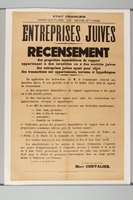
Poster announcing a Jewish Community census
Object
Poster issued by Seine-et-Oise département authorities in France declaring a Jewish community census. Jews are obliged to declare all real estate properties which they own, according to an official order from July 31, 1941.

Photocopy of a painting
Object
Part of a collection of paintings: primarily gouache, created by Holocaust survivor Zenek Maor, documenting his experiences during the Holocaust and his life in Israel; Maor (born Moskowicz) was born in Wloclawek, Poland in 1923. His family fled to Warsaw, where they were forced into the ghetto. From there he was sent to a forced labor camp to build a railway line, before being transferred to Auschwitz with his brother Heniek. There they were assigned to a work detail in the Janinagrube coal mine. On January 17, 1945, Zenek and Heniek were forced on a death march towards Germany. After Zenek's liberation by the Red Army, he returned to Wloclawek to initially discover he was the only family member to return. Heniek and Zenek went to Bavaria, and Heniek eventually immigrated to the United States. Zenek immigrated to Israel in 1947, and married Hungarian survivor Lilli. They lived at Kibbutz Yad Mordecai and eventually moved to Haifa; created in 2005.

Painting
Object
Part of a collection of paintings: primarily gouache, created by Holocaust survivor Zenek Maor, documenting his experiences during the Holocaust and his life in Israel; Maor (born Moskowicz) was born in Wloclawek, Poland in 1923. His family fled to Warsaw, where they were forced into the ghetto. From there he was sent to a forced labor camp to build a railway line, before being transferred to Auschwitz with his brother Heniek. There they were assigned to a work detail in the Janinagrube coal mine. On January 17, 1945, Zenek and Heniek were forced on a death march towards Germany. After Zenek's liberation by the Red Army, he returned to Wloclawek to initially discover he was the only family member to return. Heniek and Zenek went to Bavaria, and Heniek eventually immigrated to the United States. Zenek immigrated to Israel in 1947, and married Hungarian survivor Lilli. They lived at Kibbutz Yad Mordecai and eventually moved to Haifa; created in 2005.

Painting
Object
Part of a collection of paintings: primarily gouache, created by Holocaust survivor Zenek Maor, documenting his experiences during the Holocaust and his life in Israel; Maor (born Moskowicz) was born in Wloclawek, Poland in 1923. His family fled to Warsaw, where they were forced into the ghetto. From there he was sent to a forced labor camp to build a railway line, before being transferred to Auschwitz with his brother Heniek. There they were assigned to a work detail in the Janinagrube coal mine. On January 17, 1945, Zenek and Heniek were forced on a death march towards Germany. After Zenek's liberation by the Red Army, he returned to Wloclawek to initially discover he was the only family member to return. Heniek and Zenek went to Bavaria, and Heniek eventually immigrated to the United States. Zenek immigrated to Israel in 1947, and married Hungarian survivor Lilli. They lived at Kibbutz Yad Mordecai and eventually moved to Haifa; created in 2005.

Painting
Object
Part of a collection of paintings: primarily gouache, created by Holocaust survivor Zenek Maor, documenting his experiences during the Holocaust and his life in Israel; Maor (born Moskowicz) was born in Wloclawek, Poland in 1923. His family fled to Warsaw, where they were forced into the ghetto. From there he was sent to a forced labor camp to build a railway line, before being transferred to Auschwitz with his brother Heniek. There they were assigned to a work detail in the Janinagrube coal mine. On January 17, 1945, Zenek and Heniek were forced on a death march towards Germany. After Zenek's liberation by the Red Army, he returned to Wloclawek to initially discover he was the only family member to return. Heniek and Zenek went to Bavaria, and Heniek eventually immigrated to the United States. Zenek immigrated to Israel in 1947, and married Hungarian survivor Lilli. They lived at Kibbutz Yad Mordecai and eventually moved to Haifa; created in 2005.

Painting
Object
Part of a collection of paintings: primarily gouache, created by Holocaust survivor Zenek Maor, documenting his experiences during the Holocaust and his life in Israel; Maor (born Moskowicz) was born in Wloclawek, Poland in 1923. His family fled to Warsaw, where they were forced into the ghetto. From there he was sent to a forced labor camp to build a railway line, before being transferred to Auschwitz with his brother Heniek. There they were assigned to a work detail in the Janinagrube coal mine. On January 17, 1945, Zenek and Heniek were forced on a death march towards Germany. After Zenek's liberation by the Red Army, he returned to Wloclawek to initially discover he was the only family member to return. Heniek and Zenek went to Bavaria, and Heniek eventually immigrated to the United States. Zenek immigrated to Israel in 1947, and married Hungarian survivor Lilli. They lived at Kibbutz Yad Mordecai and eventually moved to Haifa; created in 2005.

Painting
Object
Part of a collection of paintings: primarily gouache, created by Holocaust survivor Zenek Maor, documenting his experiences during the Holocaust and his life in Israel; Maor (born Moskowicz) was born in Wloclawek, Poland in 1923. His family fled to Warsaw, where they were forced into the ghetto. From there he was sent to a forced labor camp to build a railway line, before being transferred to Auschwitz with his brother Heniek. There they were assigned to a work detail in the Janinagrube coal mine. On January 17, 1945, Zenek and Heniek were forced on a death march towards Germany. After Zenek's liberation by the Red Army, he returned to Wloclawek to initially discover he was the only family member to return. Heniek and Zenek went to Bavaria, and Heniek eventually immigrated to the United States. Zenek immigrated to Israel in 1947, and married Hungarian survivor Lilli. They lived at Kibbutz Yad Mordecai and eventually moved to Haifa; created in 2005.

Painting
Object
Part of a collection of paintings: primarily gouache, created by Holocaust survivor Zenek Maor, documenting his experiences during the Holocaust and his life in Israel; Maor (born Moskowicz) was born in Wloclawek, Poland in 1923. His family fled to Warsaw, where they were forced into the ghetto. From there he was sent to a forced labor camp to build a railway line, before being transferred to Auschwitz with his brother Heniek. There they were assigned to a work detail in the Janinagrube coal mine. On January 17, 1945, Zenek and Heniek were forced on a death march towards Germany. After Zenek's liberation by the Red Army, he returned to Wloclawek to initially discover he was the only family member to return. Heniek and Zenek went to Bavaria, and Heniek eventually immigrated to the United States. Zenek immigrated to Israel in 1947, and married Hungarian survivor Lilli. They lived at Kibbutz Yad Mordecai and eventually moved to Haifa; created in 2005.

Drawing
Object
Part of a collection of paintings: primarily gouache, created by Holocaust survivor Zenek Maor, documenting his experiences during the Holocaust and his life in Israel; Maor (born Moskowicz) was born in Wloclawek, Poland in 1923. His family fled to Warsaw, where they were forced into the ghetto. From there he was sent to a forced labor camp to build a railway line, before being transferred to Auschwitz with his brother Heniek. There they were assigned to a work detail in the Janinagrube coal mine. On January 17, 1945, Zenek and Heniek were forced on a death march towards Germany. After Zenek's liberation by the Red Army, he returned to Wloclawek to initially discover he was the only family member to return. Heniek and Zenek went to Bavaria, and Heniek eventually immigrated to the United States. Zenek immigrated to Israel in 1947, and married Hungarian survivor Lilli. They lived at Kibbutz Yad Mordecai and eventually moved to Haifa; created in 2005.
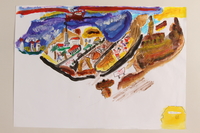
Painting
Object
Part of a collection of paintings: primarily gouache, created by Holocaust survivor Zenek Maor, documenting his experiences during the Holocaust and his life in Israel; Maor (born Moskowicz) was born in Wloclawek, Poland in 1923. His family fled to Warsaw, where they were forced into the ghetto. From there he was sent to a forced labor camp to build a railway line, before being transferred to Auschwitz with his brother Heniek. There they were assigned to a work detail in the Janinagrube coal mine. On January 17, 1945, Zenek and Heniek were forced on a death march towards Germany. After Zenek's liberation by the Red Army, he returned to Wloclawek to initially discover he was the only family member to return. Heniek and Zenek went to Bavaria, and Heniek eventually immigrated to the United States. Zenek immigrated to Israel in 1947, and married Hungarian survivor Lilli. They lived at Kibbutz Yad Mordecai and eventually moved to Haifa; created in 2005.

Painting
Object
Part of a collection of paintings: primarily gouache, created by Holocaust survivor Zenek Maor, documenting his experiences during the Holocaust and his life in Israel; Maor (born Moskowicz) was born in Wloclawek, Poland in 1923. His family fled to Warsaw, where they were forced into the ghetto. From there he was sent to a forced labor camp to build a railway line, before being transferred to Auschwitz with his brother Heniek. There they were assigned to a work detail in the Janinagrube coal mine. On January 17, 1945, Zenek and Heniek were forced on a death march towards Germany. After Zenek's liberation by the Red Army, he returned to Wloclawek to initially discover he was the only family member to return. Heniek and Zenek went to Bavaria, and Heniek eventually immigrated to the United States. Zenek immigrated to Israel in 1947, and married Hungarian survivor Lilli. They lived at Kibbutz Yad Mordecai and eventually moved to Haifa; created in 2005.

Painting
Object
Part of a collection of paintings: primarily gouache, created by Holocaust survivor Zenek Maor, documenting his experiences during the Holocaust and his life in Israel; Maor (born Moskowicz) was born in Wloclawek, Poland in 1923. His family fled to Warsaw, where they were forced into the ghetto. From there he was sent to a forced labor camp to build a railway line, before being transferred to Auschwitz with his brother Heniek. There they were assigned to a work detail in the Janinagrube coal mine. On January 17, 1945, Zenek and Heniek were forced on a death march towards Germany. After Zenek's liberation by the Red Army, he returned to Wloclawek to initially discover he was the only family member to return. Heniek and Zenek went to Bavaria, and Heniek eventually immigrated to the United States. Zenek immigrated to Israel in 1947, and married Hungarian survivor Lilli. They lived at Kibbutz Yad Mordecai and eventually moved to Haifa; created in 2005.

Painting
Object
Part of a collection of paintings: primarily gouache, created by Holocaust survivor Zenek Maor, documenting his experiences during the Holocaust and his life in Israel; Maor (born Moskowicz) was born in Wloclawek, Poland in 1923. His family fled to Warsaw, where they were forced into the ghetto. From there he was sent to a forced labor camp to build a railway line, before being transferred to Auschwitz with his brother Heniek. There they were assigned to a work detail in the Janinagrube coal mine. On January 17, 1945, Zenek and Heniek were forced on a death march towards Germany. After Zenek's liberation by the Red Army, he returned to Wloclawek to initially discover he was the only family member to return. Heniek and Zenek went to Bavaria, and Heniek eventually immigrated to the United States. Zenek immigrated to Israel in 1947, and married Hungarian survivor Lilli. They lived at Kibbutz Yad Mordecai and eventually moved to Haifa; created in 2005.
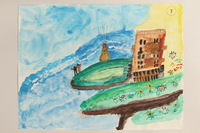
Painting
Object
Part of a collection of paintings: primarily gouache, created by Holocaust survivor Zenek Maor, documenting his experiences during the Holocaust and his life in Israel; Maor (born Moskowicz) was born in Wloclawek, Poland in 1923. His family fled to Warsaw, where they were forced into the ghetto. From there he was sent to a forced labor camp to build a railway line, before being transferred to Auschwitz with his brother Heniek. There they were assigned to a work detail in the Janinagrube coal mine. On January 17, 1945, Zenek and Heniek were forced on a death march towards Germany. After Zenek's liberation by the Red Army, he returned to Wloclawek to initially discover he was the only family member to return. Heniek and Zenek went to Bavaria, and Heniek eventually immigrated to the United States. Zenek immigrated to Israel in 1947, and married Hungarian survivor Lilli. They lived at Kibbutz Yad Mordecai and eventually moved to Haifa; created in 2005.

Painting
Object
Part of a collection of paintings: primarily gouache, created by Holocaust survivor Zenek Maor, documenting his experiences during the Holocaust and his life in Israel; Maor (born Moskowicz) was born in Wloclawek, Poland in 1923. His family fled to Warsaw, where they were forced into the ghetto. From there he was sent to a forced labor camp to build a railway line, before being transferred to Auschwitz with his brother Heniek. There they were assigned to a work detail in the Janinagrube coal mine. On January 17, 1945, Zenek and Heniek were forced on a death march towards Germany. After Zenek's liberation by the Red Army, he returned to Wloclawek to initially discover he was the only family member to return. Heniek and Zenek went to Bavaria, and Heniek eventually immigrated to the United States. Zenek immigrated to Israel in 1947, and married Hungarian survivor Lilli. They lived at Kibbutz Yad Mordecai and eventually moved to Haifa; created in 2005.
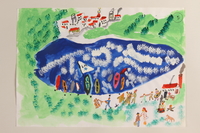
Painting
Object
Part of a collection of paintings: primarily gouache, created by Holocaust survivor Zenek Maor, documenting his experiences during the Holocaust and his life in Israel; Maor (born Moskowicz) was born in Wloclawek, Poland in 1923. His family fled to Warsaw, where they were forced into the ghetto. From there he was sent to a forced labor camp to build a railway line, before being transferred to Auschwitz with his brother Heniek. There they were assigned to a work detail in the Janinagrube coal mine. On January 17, 1945, Zenek and Heniek were forced on a death march towards Germany. After Zenek's liberation by the Red Army, he returned to Wloclawek to initially discover he was the only family member to return. Heniek and Zenek went to Bavaria, and Heniek eventually immigrated to the United States. Zenek immigrated to Israel in 1947, and married Hungarian survivor Lilli. They lived at Kibbutz Yad Mordecai and eventually moved to Haifa; created in 2005.

Painting
Object
Part of a collection of paintings: primarily gouache, created by Holocaust survivor Zenek Maor, documenting his experiences during the Holocaust and his life in Israel; Maor (born Moskowicz) was born in Wloclawek, Poland in 1923. His family fled to Warsaw, where they were forced into the ghetto. From there he was sent to a forced labor camp to build a railway line, before being transferred to Auschwitz with his brother Heniek. There they were assigned to a work detail in the Janinagrube coal mine. On January 17, 1945, Zenek and Heniek were forced on a death march towards Germany. After Zenek's liberation by the Red Army, he returned to Wloclawek to initially discover he was the only family member to return. Heniek and Zenek went to Bavaria, and Heniek eventually immigrated to the United States. Zenek immigrated to Israel in 1947, and married Hungarian survivor Lilli. They lived at Kibbutz Yad Mordecai and eventually moved to Haifa; created in 2005.
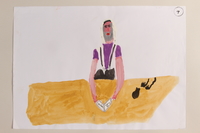
Painting
Object
Part of a collection of paintings: primarily gouache, created by Holocaust survivor Zenek Maor, documenting his experiences during the Holocaust and his life in Israel; Maor (born Moskowicz) was born in Wloclawek, Poland in 1923. His family fled to Warsaw, where they were forced into the ghetto. From there he was sent to a forced labor camp to build a railway line, before being transferred to Auschwitz with his brother Heniek. There they were assigned to a work detail in the Janinagrube coal mine. On January 17, 1945, Zenek and Heniek were forced on a death march towards Germany. After Zenek's liberation by the Red Army, he returned to Wloclawek to initially discover he was the only family member to return. Heniek and Zenek went to Bavaria, and Heniek eventually immigrated to the United States. Zenek immigrated to Israel in 1947, and married Hungarian survivor Lilli. They lived at Kibbutz Yad Mordecai and eventually moved to Haifa; created in 2005.

Painting
Object
Part of a collection of paintings: primarily gouache, created by Holocaust survivor Zenek Maor, documenting his experiences during the Holocaust and his life in Israel; Maor (born Moskowicz) was born in Wloclawek, Poland in 1923. His family fled to Warsaw, where they were forced into the ghetto. From there he was sent to a forced labor camp to build a railway line, before being transferred to Auschwitz with his brother Heniek. There they were assigned to a work detail in the Janinagrube coal mine. On January 17, 1945, Zenek and Heniek were forced on a death march towards Germany. After Zenek's liberation by the Red Army, he returned to Wloclawek to initially discover he was the only family member to return. Heniek and Zenek went to Bavaria, and Heniek eventually immigrated to the United States. Zenek immigrated to Israel in 1947, and married Hungarian survivor Lilli. They lived at Kibbutz Yad Mordecai and eventually moved to Haifa; created in 2005.

Painting
Object
Part of a collection of paintings: primarily gouache, created by Holocaust survivor Zenek Maor, documenting his experiences during the Holocaust and his life in Israel; Maor (born Moskowicz) was born in Wloclawek, Poland in 1923. His family fled to Warsaw, where they were forced into the ghetto. From there he was sent to a forced labor camp to build a railway line, before being transferred to Auschwitz with his brother Heniek. There they were assigned to a work detail in the Janinagrube coal mine. On January 17, 1945, Zenek and Heniek were forced on a death march towards Germany. After Zenek's liberation by the Red Army, he returned to Wloclawek to initially discover he was the only family member to return. Heniek and Zenek went to Bavaria, and Heniek eventually immigrated to the United States. Zenek immigrated to Israel in 1947, and married Hungarian survivor Lilli. They lived at Kibbutz Yad Mordecai and eventually moved to Haifa; created in 2005.

Painting
Object
Part of a collection of paintings: primarily gouache, created by Holocaust survivor Zenek Maor, documenting his experiences during the Holocaust and his life in Israel; Maor (born Moskowicz) was born in Wloclawek, Poland in 1923. His family fled to Warsaw, where they were forced into the ghetto. From there he was sent to a forced labor camp to build a railway line, before being transferred to Auschwitz with his brother Heniek. There they were assigned to a work detail in the Janinagrube coal mine. On January 17, 1945, Zenek and Heniek were forced on a death march towards Germany. After Zenek's liberation by the Red Army, he returned to Wloclawek to initially discover he was the only family member to return. Heniek and Zenek went to Bavaria, and Heniek eventually immigrated to the United States. Zenek immigrated to Israel in 1947, and married Hungarian survivor Lilli. They lived at Kibbutz Yad Mordecai and eventually moved to Haifa; created in 2005.

Painting
Object
Part of a collection of paintings: primarily gouache, created by Holocaust survivor Zenek Maor, documenting his experiences during the Holocaust and his life in Israel; Maor (born Moskowicz) was born in Wloclawek, Poland in 1923. His family fled to Warsaw, where they were forced into the ghetto. From there he was sent to a forced labor camp to build a railway line, before being transferred to Auschwitz with his brother Heniek. There they were assigned to a work detail in the Janinagrube coal mine. On January 17, 1945, Zenek and Heniek were forced on a death march towards Germany. After Zenek's liberation by the Red Army, he returned to Wloclawek to initially discover he was the only family member to return. Heniek and Zenek went to Bavaria, and Heniek eventually immigrated to the United States. Zenek immigrated to Israel in 1947, and married Hungarian survivor Lilli. They lived at Kibbutz Yad Mordecai and eventually moved to Haifa; created in 2005.
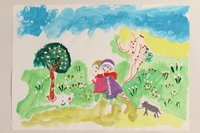
Painting
Object
Part of a collection of paintings: primarily gouache, created by Holocaust survivor Zenek Maor, documenting his experiences during the Holocaust and his life in Israel; Maor (born Moskowicz) was born in Wloclawek, Poland in 1923. His family fled to Warsaw, where they were forced into the ghetto. From there he was sent to a forced labor camp to build a railway line, before being transferred to Auschwitz with his brother Heniek. There they were assigned to a work detail in the Janinagrube coal mine. On January 17, 1945, Zenek and Heniek were forced on a death march towards Germany. After Zenek's liberation by the Red Army, he returned to Wloclawek to initially discover he was the only family member to return. Heniek and Zenek went to Bavaria, and Heniek eventually immigrated to the United States. Zenek immigrated to Israel in 1947, and married Hungarian survivor Lilli. They lived at Kibbutz Yad Mordecai and eventually moved to Haifa; created in 2005.

Painting
Object
Part of a collection of paintings: primarily gouache, created by Holocaust survivor Zenek Maor, documenting his experiences during the Holocaust and his life in Israel; Maor (born Moskowicz) was born in Wloclawek, Poland in 1923. His family fled to Warsaw, where they were forced into the ghetto. From there he was sent to a forced labor camp to build a railway line, before being transferred to Auschwitz with his brother Heniek. There they were assigned to a work detail in the Janinagrube coal mine. On January 17, 1945, Zenek and Heniek were forced on a death march towards Germany. After Zenek's liberation by the Red Army, he returned to Wloclawek to initially discover he was the only family member to return. Heniek and Zenek went to Bavaria, and Heniek eventually immigrated to the United States. Zenek immigrated to Israel in 1947, and married Hungarian survivor Lilli. They lived at Kibbutz Yad Mordecai and eventually moved to Haifa; created in 2005.
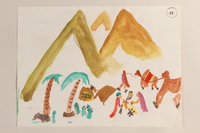
Painting
Object
Part of a collection of paintings: primarily gouache, created by Holocaust survivor Zenek Maor, documenting his experiences during the Holocaust and his life in Israel; Maor (born Moskowicz) was born in Wloclawek, Poland in 1923. His family fled to Warsaw, where they were forced into the ghetto. From there he was sent to a forced labor camp to build a railway line, before being transferred to Auschwitz with his brother Heniek. There they were assigned to a work detail in the Janinagrube coal mine. On January 17, 1945, Zenek and Heniek were forced on a death march towards Germany. After Zenek's liberation by the Red Army, he returned to Wloclawek to initially discover he was the only family member to return. Heniek and Zenek went to Bavaria, and Heniek eventually immigrated to the United States. Zenek immigrated to Israel in 1947, and married Hungarian survivor Lilli. They lived at Kibbutz Yad Mordecai and eventually moved to Haifa; created in 2005.

Painting
Object
Part of a collection of paintings: primarily gouache, created by Holocaust survivor Zenek Maor, documenting his experiences during the Holocaust and his life in Israel; Maor (born Moskowicz) was born in Wloclawek, Poland in 1923. His family fled to Warsaw, where they were forced into the ghetto. From there he was sent to a forced labor camp to build a railway line, before being transferred to Auschwitz with his brother Heniek. There they were assigned to a work detail in the Janinagrube coal mine. On January 17, 1945, Zenek and Heniek were forced on a death march towards Germany. After Zenek's liberation by the Red Army, he returned to Wloclawek to initially discover he was the only family member to return. Heniek and Zenek went to Bavaria, and Heniek eventually immigrated to the United States. Zenek immigrated to Israel in 1947, and married Hungarian survivor Lilli. They lived at Kibbutz Yad Mordecai and eventually moved to Haifa; created in 2005.

Painting
Object
Part of a collection of paintings: primarily gouache, created by Holocaust survivor Zenek Maor, documenting his experiences during the Holocaust and his life in Israel; Maor (born Moskowicz) was born in Wloclawek, Poland in 1923. His family fled to Warsaw, where they were forced into the ghetto. From there he was sent to a forced labor camp to build a railway line, before being transferred to Auschwitz with his brother Heniek. There they were assigned to a work detail in the Janinagrube coal mine. On January 17, 1945, Zenek and Heniek were forced on a death march towards Germany. After Zenek's liberation by the Red Army, he returned to Wloclawek to initially discover he was the only family member to return. Heniek and Zenek went to Bavaria, and Heniek eventually immigrated to the United States. Zenek immigrated to Israel in 1947, and married Hungarian survivor Lilli. They lived at Kibbutz Yad Mordecai and eventually moved to Haifa; created in 2005.

Painting
Object
Part of a collection of paintings: primarily gouache, created by Holocaust survivor Zenek Maor, documenting his experiences during the Holocaust and his life in Israel; Maor (born Moskowicz) was born in Wloclawek, Poland in 1923. His family fled to Warsaw, where they were forced into the ghetto. From there he was sent to a forced labor camp to build a railway line, before being transferred to Auschwitz with his brother Heniek. There they were assigned to a work detail in the Janinagrube coal mine. On January 17, 1945, Zenek and Heniek were forced on a death march towards Germany. After Zenek's liberation by the Red Army, he returned to Wloclawek to initially discover he was the only family member to return. Heniek and Zenek went to Bavaria, and Heniek eventually immigrated to the United States. Zenek immigrated to Israel in 1947, and married Hungarian survivor Lilli. They lived at Kibbutz Yad Mordecai and eventually moved to Haifa; created in 2005.

Painting
Object
Part of a collection of paintings: primarily gouache, created by Holocaust survivor Zenek Maor, documenting his experiences during the Holocaust and his life in Israel; Maor (born Moskowicz) was born in Wloclawek, Poland in 1923. His family fled to Warsaw, where they were forced into the ghetto. From there he was sent to a forced labor camp to build a railway line, before being transferred to Auschwitz with his brother Heniek. There they were assigned to a work detail in the Janinagrube coal mine. On January 17, 1945, Zenek and Heniek were forced on a death march towards Germany. After Zenek's liberation by the Red Army, he returned to Wloclawek to initially discover he was the only family member to return. Heniek and Zenek went to Bavaria, and Heniek eventually immigrated to the United States. Zenek immigrated to Israel in 1947, and married Hungarian survivor Lilli. They lived at Kibbutz Yad Mordecai and eventually moved to Haifa; created in 2005.

Painting
Object
Part of a collection of paintings: primarily gouache, created by Holocaust survivor Zenek Maor, documenting his experiences during the Holocaust and his life in Israel; Maor (born Moskowicz) was born in Wloclawek, Poland in 1923. His family fled to Warsaw, where they were forced into the ghetto. From there he was sent to a forced labor camp to build a railway line, before being transferred to Auschwitz with his brother Heniek. There they were assigned to a work detail in the Janinagrube coal mine. On January 17, 1945, Zenek and Heniek were forced on a death march towards Germany. After Zenek's liberation by the Red Army, he returned to Wloclawek to initially discover he was the only family member to return. Heniek and Zenek went to Bavaria, and Heniek eventually immigrated to the United States. Zenek immigrated to Israel in 1947, and married Hungarian survivor Lilli. They lived at Kibbutz Yad Mordecai and eventually moved to Haifa; created in 2005.

Painting
Object
Part of a collection of paintings: primarily gouache, created by Holocaust survivor Zenek Maor, documenting his experiences during the Holocaust and his life in Israel; Maor (born Moskowicz) was born in Wloclawek, Poland in 1923. His family fled to Warsaw, where they were forced into the ghetto. From there he was sent to a forced labor camp to build a railway line, before being transferred to Auschwitz with his brother Heniek. There they were assigned to a work detail in the Janinagrube coal mine. On January 17, 1945, Zenek and Heniek were forced on a death march towards Germany. After Zenek's liberation by the Red Army, he returned to Wloclawek to initially discover he was the only family member to return. Heniek and Zenek went to Bavaria, and Heniek eventually immigrated to the United States. Zenek immigrated to Israel in 1947, and married Hungarian survivor Lilli. They lived at Kibbutz Yad Mordecai and eventually moved to Haifa; created in 2005.

Painting
Object
Part of a collection of paintings: primarily gouache, created by Holocaust survivor Zenek Maor, documenting his experiences during the Holocaust and his life in Israel; Maor (born Moskowicz) was born in Wloclawek, Poland in 1923. His family fled to Warsaw, where they were forced into the ghetto. From there he was sent to a forced labor camp to build a railway line, before being transferred to Auschwitz with his brother Heniek. There they were assigned to a work detail in the Janinagrube coal mine. On January 17, 1945, Zenek and Heniek were forced on a death march towards Germany. After Zenek's liberation by the Red Army, he returned to Wloclawek to initially discover he was the only family member to return. Heniek and Zenek went to Bavaria, and Heniek eventually immigrated to the United States. Zenek immigrated to Israel in 1947, and married Hungarian survivor Lilli. They lived at Kibbutz Yad Mordecai and eventually moved to Haifa; created in 2005.
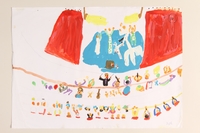
Painting
Object
Part of a collection of paintings: primarily gouache, created by Holocaust survivor Zenek Maor, documenting his experiences during the Holocaust and his life in Israel; Maor (born Moskowicz) was born in Wloclawek, Poland in 1923. His family fled to Warsaw, where they were forced into the ghetto. From there he was sent to a forced labor camp to build a railway line, before being transferred to Auschwitz with his brother Heniek. There they were assigned to a work detail in the Janinagrube coal mine. On January 17, 1945, Zenek and Heniek were forced on a death march towards Germany. After Zenek's liberation by the Red Army, he returned to Wloclawek to initially discover he was the only family member to return. Heniek and Zenek went to Bavaria, and Heniek eventually immigrated to the United States. Zenek immigrated to Israel in 1947, and married Hungarian survivor Lilli. They lived at Kibbutz Yad Mordecai and eventually moved to Haifa; created in 2005.

Painting
Object
Part of a collection of paintings: primarily gouache, created by Holocaust survivor Zenek Maor, documenting his experiences during the Holocaust and his life in Israel; Maor (born Moskowicz) was born in Wloclawek, Poland in 1923. His family fled to Warsaw, where they were forced into the ghetto. From there he was sent to a forced labor camp to build a railway line, before being transferred to Auschwitz with his brother Heniek. There they were assigned to a work detail in the Janinagrube coal mine. On January 17, 1945, Zenek and Heniek were forced on a death march towards Germany. After Zenek's liberation by the Red Army, he returned to Wloclawek to initially discover he was the only family member to return. Heniek and Zenek went to Bavaria, and Heniek eventually immigrated to the United States. Zenek immigrated to Israel in 1947, and married Hungarian survivor Lilli. They lived at Kibbutz Yad Mordecai and eventually moved to Haifa; created in 2005.

Painting
Object
Part of a collection of paintings: primarily gouache, created by Holocaust survivor Zenek Maor, documenting his experiences during the Holocaust and his life in Israel; Maor (born Moskowicz) was born in Wloclawek, Poland in 1923. His family fled to Warsaw, where they were forced into the ghetto. From there he was sent to a forced labor camp to build a railway line, before being transferred to Auschwitz with his brother Heniek. There they were assigned to a work detail in the Janinagrube coal mine. On January 17, 1945, Zenek and Heniek were forced on a death march towards Germany. After Zenek's liberation by the Red Army, he returned to Wloclawek to initially discover he was the only family member to return. Heniek and Zenek went to Bavaria, and Heniek eventually immigrated to the United States. Zenek immigrated to Israel in 1947, and married Hungarian survivor Lilli. They lived at Kibbutz Yad Mordecai and eventually moved to Haifa; created in 2005.
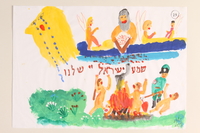
Painting
Object
Part of a collection of paintings: primarily gouache, created by Holocaust survivor Zenek Maor, documenting his experiences during the Holocaust and his life in Israel; Maor (born Moskowicz) was born in Wloclawek, Poland in 1923. His family fled to Warsaw, where they were forced into the ghetto. From there he was sent to a forced labor camp to build a railway line, before being transferred to Auschwitz with his brother Heniek. There they were assigned to a work detail in the Janinagrube coal mine. On January 17, 1945, Zenek and Heniek were forced on a death march towards Germany. After Zenek's liberation by the Red Army, he returned to Wloclawek to initially discover he was the only family member to return. Heniek and Zenek went to Bavaria, and Heniek eventually immigrated to the United States. Zenek immigrated to Israel in 1947, and married Hungarian survivor Lilli. They lived at Kibbutz Yad Mordecai and eventually moved to Haifa; created in 2005.

Painting
Object
Part of a collection of paintings: primarily gouache, created by Holocaust survivor Zenek Maor, documenting his experiences during the Holocaust and his life in Israel; Maor (born Moskowicz) was born in Wloclawek, Poland in 1923. His family fled to Warsaw, where they were forced into the ghetto. From there he was sent to a forced labor camp to build a railway line, before being transferred to Auschwitz with his brother Heniek. There they were assigned to a work detail in the Janinagrube coal mine. On January 17, 1945, Zenek and Heniek were forced on a death march towards Germany. After Zenek's liberation by the Red Army, he returned to Wloclawek to initially discover he was the only family member to return. Heniek and Zenek went to Bavaria, and Heniek eventually immigrated to the United States. Zenek immigrated to Israel in 1947, and married Hungarian survivor Lilli. They lived at Kibbutz Yad Mordecai and eventually moved to Haifa; created in 2005.

Painting
Object
Part of a collection of paintings: primarily gouache, created by Holocaust survivor Zenek Maor, documenting his experiences during the Holocaust and his life in Israel; Maor (born Moskowicz) was born in Wloclawek, Poland in 1923. His family fled to Warsaw, where they were forced into the ghetto. From there he was sent to a forced labor camp to build a railway line, before being transferred to Auschwitz with his brother Heniek. There they were assigned to a work detail in the Janinagrube coal mine. On January 17, 1945, Zenek and Heniek were forced on a death march towards Germany. After Zenek's liberation by the Red Army, he returned to Wloclawek to initially discover he was the only family member to return. Heniek and Zenek went to Bavaria, and Heniek eventually immigrated to the United States. Zenek immigrated to Israel in 1947, and married Hungarian survivor Lilli. They lived at Kibbutz Yad Mordecai and eventually moved to Haifa; created in 2005.

Painting
Object
Part of a collection of paintings: primarily gouache, created by Holocaust survivor Zenek Maor, documenting his experiences during the Holocaust and his life in Israel; Maor (born Moskowicz) was born in Wloclawek, Poland in 1923. His family fled to Warsaw, where they were forced into the ghetto. From there he was sent to a forced labor camp to build a railway line, before being transferred to Auschwitz with his brother Heniek. There they were assigned to a work detail in the Janinagrube coal mine. On January 17, 1945, Zenek and Heniek were forced on a death march towards Germany. After Zenek's liberation by the Red Army, he returned to Wloclawek to initially discover he was the only family member to return. Heniek and Zenek went to Bavaria, and Heniek eventually immigrated to the United States. Zenek immigrated to Israel in 1947, and married Hungarian survivor Lilli. They lived at Kibbutz Yad Mordecai and eventually moved to Haifa; created in 2005.

Painting
Object
Part of a collection of paintings: primarily gouache, created by Holocaust survivor Zenek Maor, documenting his experiences during the Holocaust and his life in Israel; Maor (born Moskowicz) was born in Wloclawek, Poland in 1923. His family fled to Warsaw, where they were forced into the ghetto. From there he was sent to a forced labor camp to build a railway line, before being transferred to Auschwitz with his brother Heniek. There they were assigned to a work detail in the Janinagrube coal mine. On January 17, 1945, Zenek and Heniek were forced on a death march towards Germany. After Zenek's liberation by the Red Army, he returned to Wloclawek to initially discover he was the only family member to return. Heniek and Zenek went to Bavaria, and Heniek eventually immigrated to the United States. Zenek immigrated to Israel in 1947, and married Hungarian survivor Lilli. They lived at Kibbutz Yad Mordecai and eventually moved to Haifa; created in 2005.

Painting
Object
Part of a collection of paintings: primarily gouache, created by Holocaust survivor Zenek Maor, documenting his experiences during the Holocaust and his life in Israel; Maor (born Moskowicz) was born in Wloclawek, Poland in 1923. His family fled to Warsaw, where they were forced into the ghetto. From there he was sent to a forced labor camp to build a railway line, before being transferred to Auschwitz with his brother Heniek. There they were assigned to a work detail in the Janinagrube coal mine. On January 17, 1945, Zenek and Heniek were forced on a death march towards Germany. After Zenek's liberation by the Red Army, he returned to Wloclawek to initially discover he was the only family member to return. Heniek and Zenek went to Bavaria, and Heniek eventually immigrated to the United States. Zenek immigrated to Israel in 1947, and married Hungarian survivor Lilli. They lived at Kibbutz Yad Mordecai and eventually moved to Haifa; created in 2005.

Painting
Object
Part of a collection of paintings: primarily gouache, created by Holocaust survivor Zenek Maor, documenting his experiences during the Holocaust and his life in Israel; Maor (born Moskowicz) was born in Wloclawek, Poland in 1923. His family fled to Warsaw, where they were forced into the ghetto. From there he was sent to a forced labor camp to build a railway line, before being transferred to Auschwitz with his brother Heniek. There they were assigned to a work detail in the Janinagrube coal mine. On January 17, 1945, Zenek and Heniek were forced on a death march towards Germany. After Zenek's liberation by the Red Army, he returned to Wloclawek to initially discover he was the only family member to return. Heniek and Zenek went to Bavaria, and Heniek eventually immigrated to the United States. Zenek immigrated to Israel in 1947, and married Hungarian survivor Lilli. They lived at Kibbutz Yad Mordecai and eventually moved to Haifa; created in 2005.

Painting
Object
Part of a collection of paintings: primarily gouache, created by Holocaust survivor Zenek Maor, documenting his experiences during the Holocaust and his life in Israel; Maor (born Moskowicz) was born in Wloclawek, Poland in 1923. His family fled to Warsaw, where they were forced into the ghetto. From there he was sent to a forced labor camp to build a railway line, before being transferred to Auschwitz with his brother Heniek. There they were assigned to a work detail in the Janinagrube coal mine. On January 17, 1945, Zenek and Heniek were forced on a death march towards Germany. After Zenek's liberation by the Red Army, he returned to Wloclawek to initially discover he was the only family member to return. Heniek and Zenek went to Bavaria, and Heniek eventually immigrated to the United States. Zenek immigrated to Israel in 1947, and married Hungarian survivor Lilli. They lived at Kibbutz Yad Mordecai and eventually moved to Haifa; created in 2005.

Painting
Object
Part of a collection of paintings: primarily gouache, created by Holocaust survivor Zenek Maor, documenting his experiences during the Holocaust and his life in Israel; Maor (born Moskowicz) was born in Wloclawek, Poland in 1923. His family fled to Warsaw, where they were forced into the ghetto. From there he was sent to a forced labor camp to build a railway line, before being transferred to Auschwitz with his brother Heniek. There they were assigned to a work detail in the Janinagrube coal mine. On January 17, 1945, Zenek and Heniek were forced on a death march towards Germany. After Zenek's liberation by the Red Army, he returned to Wloclawek to initially discover he was the only family member to return. Heniek and Zenek went to Bavaria, and Heniek eventually immigrated to the United States. Zenek immigrated to Israel in 1947, and married Hungarian survivor Lilli. They lived at Kibbutz Yad Mordecai and eventually moved to Haifa; created in 2005.

Painting
Object
Part of a collection of paintings: primarily gouache, created by Holocaust survivor Zenek Maor, documenting his experiences during the Holocaust and his life in Israel; Maor (born Moskowicz) was born in Wloclawek, Poland in 1923. His family fled to Warsaw, where they were forced into the ghetto. From there he was sent to a forced labor camp to build a railway line, before being transferred to Auschwitz with his brother Heniek. There they were assigned to a work detail in the Janinagrube coal mine. On January 17, 1945, Zenek and Heniek were forced on a death march towards Germany. After Zenek's liberation by the Red Army, he returned to Wloclawek to initially discover he was the only family member to return. Heniek and Zenek went to Bavaria, and Heniek eventually immigrated to the United States. Zenek immigrated to Israel in 1947, and married Hungarian survivor Lilli. They lived at Kibbutz Yad Mordecai and eventually moved to Haifa; created in 2005.

Painting
Object
Part of a collection of paintings: primarily gouache, created by Holocaust survivor Zenek Maor, documenting his experiences during the Holocaust and his life in Israel; Maor (born Moskowicz) was born in Wloclawek, Poland in 1923. His family fled to Warsaw, where they were forced into the ghetto. From there he was sent to a forced labor camp to build a railway line, before being transferred to Auschwitz with his brother Heniek. There they were assigned to a work detail in the Janinagrube coal mine. On January 17, 1945, Zenek and Heniek were forced on a death march towards Germany. After Zenek's liberation by the Red Army, he returned to Wloclawek to initially discover he was the only family member to return. Heniek and Zenek went to Bavaria, and Heniek eventually immigrated to the United States. Zenek immigrated to Israel in 1947, and married Hungarian survivor Lilli. They lived at Kibbutz Yad Mordecai and eventually moved to Haifa; created in 2005.
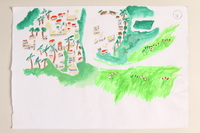
Painting
Object
Part of a collection of paintings: primarily gouache, created by Holocaust survivor Zenek Maor, documenting his experiences during the Holocaust and his life in Israel; Maor (born Moskowicz) was born in Wloclawek, Poland in 1923. His family fled to Warsaw, where they were forced into the ghetto. From there he was sent to a forced labor camp to build a railway line, before being transferred to Auschwitz with his brother Heniek. There they were assigned to a work detail in the Janinagrube coal mine. On January 17, 1945, Zenek and Heniek were forced on a death march towards Germany. After Zenek's liberation by the Red Army, he returned to Wloclawek to initially discover he was the only family member to return. Heniek and Zenek went to Bavaria, and Heniek eventually immigrated to the United States. Zenek immigrated to Israel in 1947, and married Hungarian survivor Lilli. They lived at Kibbutz Yad Mordecai and eventually moved to Haifa; created in 2005.
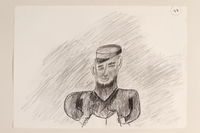
Painting
Object
Part of a collection of paintings: primarily gouache, created by Holocaust survivor Zenek Maor, documenting his experiences during the Holocaust and his life in Israel; Maor (born Moskowicz) was born in Wloclawek, Poland in 1923. His family fled to Warsaw, where they were forced into the ghetto. From there he was sent to a forced labor camp to build a railway line, before being transferred to Auschwitz with his brother Heniek. There they were assigned to a work detail in the Janinagrube coal mine. On January 17, 1945, Zenek and Heniek were forced on a death march towards Germany. After Zenek's liberation by the Red Army, he returned to Wloclawek to initially discover he was the only family member to return. Heniek and Zenek went to Bavaria, and Heniek eventually immigrated to the United States. Zenek immigrated to Israel in 1947, and married Hungarian survivor Lilli. They lived at Kibbutz Yad Mordecai and eventually moved to Haifa; created in 2005.
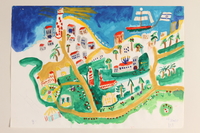
Painting
Object
Part of a collection of paintings: primarily gouache, created by Holocaust survivor Zenek Maor, documenting his experiences during the Holocaust and his life in Israel; Maor (born Moskowicz) was born in Wloclawek, Poland in 1923. His family fled to Warsaw, where they were forced into the ghetto. From there he was sent to a forced labor camp to build a railway line, before being transferred to Auschwitz with his brother Heniek. There they were assigned to a work detail in the Janinagrube coal mine. On January 17, 1945, Zenek and Heniek were forced on a death march towards Germany. After Zenek's liberation by the Red Army, he returned to Wloclawek to initially discover he was the only family member to return. Heniek and Zenek went to Bavaria, and Heniek eventually immigrated to the United States. Zenek immigrated to Israel in 1947, and married Hungarian survivor Lilli. They lived at Kibbutz Yad Mordecai and eventually moved to Haifa; created in 2005.
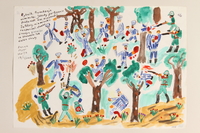
Painting
Object
Part of a collection of paintings: primarily gouache, created by Holocaust survivor Zenek Maor, documenting his experiences during the Holocaust and his life in Israel; Maor (born Moskowicz) was born in Wloclawek, Poland in 1923. His family fled to Warsaw, where they were forced into the ghetto. From there he was sent to a forced labor camp to build a railway line, before being transferred to Auschwitz with his brother Heniek. There they were assigned to a work detail in the Janinagrube coal mine. On January 17, 1945, Zenek and Heniek were forced on a death march towards Germany. After Zenek's liberation by the Red Army, he returned to Wloclawek to initially discover he was the only family member to return. Heniek and Zenek went to Bavaria, and Heniek eventually immigrated to the United States. Zenek immigrated to Israel in 1947, and married Hungarian survivor Lilli. They lived at Kibbutz Yad Mordecai and eventually moved to Haifa; created in 2005.
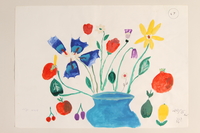
Painting
Object
Part of a collection of paintings: primarily gouache, created by Holocaust survivor Zenek Maor, documenting his experiences during the Holocaust and his life in Israel; Maor (born Moskowicz) was born in Wloclawek, Poland in 1923. His family fled to Warsaw, where they were forced into the ghetto. From there he was sent to a forced labor camp to build a railway line, before being transferred to Auschwitz with his brother Heniek. There they were assigned to a work detail in the Janinagrube coal mine. On January 17, 1945, Zenek and Heniek were forced on a death march towards Germany. After Zenek's liberation by the Red Army, he returned to Wloclawek to initially discover he was the only family member to return. Heniek and Zenek went to Bavaria, and Heniek eventually immigrated to the United States. Zenek immigrated to Israel in 1947, and married Hungarian survivor Lilli. They lived at Kibbutz Yad Mordecai and eventually moved to Haifa; created in 2005.

Painting
Object
Part of a collection of paintings: primarily gouache, created by Holocaust survivor Zenek Maor, documenting his experiences during the Holocaust and his life in Israel; Maor (born Moskowicz) was born in Wloclawek, Poland in 1923. His family fled to Warsaw, where they were forced into the ghetto. From there he was sent to a forced labor camp to build a railway line, before being transferred to Auschwitz with his brother Heniek. There they were assigned to a work detail in the Janinagrube coal mine. On January 17, 1945, Zenek and Heniek were forced on a death march towards Germany. After Zenek's liberation by the Red Army, he returned to Wloclawek to initially discover he was the only family member to return. Heniek and Zenek went to Bavaria, and Heniek eventually immigrated to the United States. Zenek immigrated to Israel in 1947, and married Hungarian survivor Lilli. They lived at Kibbutz Yad Mordecai and eventually moved to Haifa; created in 2005.

Painting
Object
Part of a collection of paintings: primarily gouache, created by Holocaust survivor Zenek Maor, documenting his experiences during the Holocaust and his life in Israel; Maor (born Moskowicz) was born in Wloclawek, Poland in 1923. His family fled to Warsaw, where they were forced into the ghetto. From there he was sent to a forced labor camp to build a railway line, before being transferred to Auschwitz with his brother Heniek. There they were assigned to a work detail in the Janinagrube coal mine. On January 17, 1945, Zenek and Heniek were forced on a death march towards Germany. After Zenek's liberation by the Red Army, he returned to Wloclawek to initially discover he was the only family member to return. Heniek and Zenek went to Bavaria, and Heniek eventually immigrated to the United States. Zenek immigrated to Israel in 1947, and married Hungarian survivor Lilli. They lived at Kibbutz Yad Mordecai and eventually moved to Haifa; created in 2005.
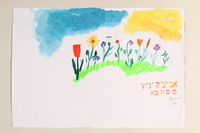
Painting
Object
Part of a collection of paintings: primarily gouache, created by Holocaust survivor Zenek Maor, documenting his experiences during the Holocaust and his life in Israel; Maor (born Moskowicz) was born in Wloclawek, Poland in 1923. His family fled to Warsaw, where they were forced into the ghetto. From there he was sent to a forced labor camp to build a railway line, before being transferred to Auschwitz with his brother Heniek. There they were assigned to a work detail in the Janinagrube coal mine. On January 17, 1945, Zenek and Heniek were forced on a death march towards Germany. After Zenek's liberation by the Red Army, he returned to Wloclawek to initially discover he was the only family member to return. Heniek and Zenek went to Bavaria, and Heniek eventually immigrated to the United States. Zenek immigrated to Israel in 1947, and married Hungarian survivor Lilli. They lived at Kibbutz Yad Mordecai and eventually moved to Haifa; created in 2005.
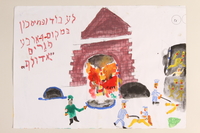
Painting
Object
Part of a collection of paintings: primarily gouache, created by Holocaust survivor Zenek Maor, documenting his experiences during the Holocaust and his life in Israel; Maor (born Moskowicz) was born in Wloclawek, Poland in 1923. His family fled to Warsaw, where they were forced into the ghetto. From there he was sent to a forced labor camp to build a railway line, before being transferred to Auschwitz with his brother Heniek. There they were assigned to a work detail in the Janinagrube coal mine. On January 17, 1945, Zenek and Heniek were forced on a death march towards Germany. After Zenek's liberation by the Red Army, he returned to Wloclawek to initially discover he was the only family member to return. Heniek and Zenek went to Bavaria, and Heniek eventually immigrated to the United States. Zenek immigrated to Israel in 1947, and married Hungarian survivor Lilli. They lived at Kibbutz Yad Mordecai and eventually moved to Haifa; created in 2005.

Painting
Object
Part of a collection of paintings: primarily gouache, created by Holocaust survivor Zenek Maor, documenting his experiences during the Holocaust and his life in Israel; Maor (born Moskowicz) was born in Wloclawek, Poland in 1923. His family fled to Warsaw, where they were forced into the ghetto. From there he was sent to a forced labor camp to build a railway line, before being transferred to Auschwitz with his brother Heniek. There they were assigned to a work detail in the Janinagrube coal mine. On January 17, 1945, Zenek and Heniek were forced on a death march towards Germany. After Zenek's liberation by the Red Army, he returned to Wloclawek to initially discover he was the only family member to return. Heniek and Zenek went to Bavaria, and Heniek eventually immigrated to the United States. Zenek immigrated to Israel in 1947, and married Hungarian survivor Lilli. They lived at Kibbutz Yad Mordecai and eventually moved to Haifa; created in 2005.

Painting
Object
Part of a collection of paintings: primarily gouache, created by Holocaust survivor Zenek Maor, documenting his experiences during the Holocaust and his life in Israel; Maor (born Moskowicz) was born in Wloclawek, Poland in 1923. His family fled to Warsaw, where they were forced into the ghetto. From there he was sent to a forced labor camp to build a railway line, before being transferred to Auschwitz with his brother Heniek. There they were assigned to a work detail in the Janinagrube coal mine. On January 17, 1945, Zenek and Heniek were forced on a death march towards Germany. After Zenek's liberation by the Red Army, he returned to Wloclawek to initially discover he was the only family member to return. Heniek and Zenek went to Bavaria, and Heniek eventually immigrated to the United States. Zenek immigrated to Israel in 1947, and married Hungarian survivor Lilli. They lived at Kibbutz Yad Mordecai and eventually moved to Haifa; created in 2005.
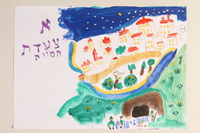
Painting
Object
Part of a collection of paintings: primarily gouache, created by Holocaust survivor Zenek Maor, documenting his experiences during the Holocaust and his life in Israel; Maor (born Moskowicz) was born in Wloclawek, Poland in 1923. His family fled to Warsaw, where they were forced into the ghetto. From there he was sent to a forced labor camp to build a railway line, before being transferred to Auschwitz with his brother Heniek. There they were assigned to a work detail in the Janinagrube coal mine. On January 17, 1945, Zenek and Heniek were forced on a death march towards Germany. After Zenek's liberation by the Red Army, he returned to Wloclawek to initially discover he was the only family member to return. Heniek and Zenek went to Bavaria, and Heniek eventually immigrated to the United States. Zenek immigrated to Israel in 1947, and married Hungarian survivor Lilli. They lived at Kibbutz Yad Mordecai and eventually moved to Haifa; created in 2005.

Painting
Object
Part of a collection of paintings: primarily gouache, created by Holocaust survivor Zenek Maor, documenting his experiences during the Holocaust and his life in Israel; Maor (born Moskowicz) was born in Wloclawek, Poland in 1923. His family fled to Warsaw, where they were forced into the ghetto. From there he was sent to a forced labor camp to build a railway line, before being transferred to Auschwitz with his brother Heniek. There they were assigned to a work detail in the Janinagrube coal mine. On January 17, 1945, Zenek and Heniek were forced on a death march towards Germany. After Zenek's liberation by the Red Army, he returned to Wloclawek to initially discover he was the only family member to return. Heniek and Zenek went to Bavaria, and Heniek eventually immigrated to the United States. Zenek immigrated to Israel in 1947, and married Hungarian survivor Lilli. They lived at Kibbutz Yad Mordecai and eventually moved to Haifa; created in 2005.

Painting
Object
Part of a collection of paintings: primarily gouache, created by Holocaust survivor Zenek Maor, documenting his experiences during the Holocaust and his life in Israel; Maor (born Moskowicz) was born in Wloclawek, Poland in 1923. His family fled to Warsaw, where they were forced into the ghetto. From there he was sent to a forced labor camp to build a railway line, before being transferred to Auschwitz with his brother Heniek. There they were assigned to a work detail in the Janinagrube coal mine. On January 17, 1945, Zenek and Heniek were forced on a death march towards Germany. After Zenek's liberation by the Red Army, he returned to Wloclawek to initially discover he was the only family member to return. Heniek and Zenek went to Bavaria, and Heniek eventually immigrated to the United States. Zenek immigrated to Israel in 1947, and married Hungarian survivor Lilli. They lived at Kibbutz Yad Mordecai and eventually moved to Haifa; created in 2005.
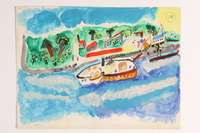
Painting
Object
Part of a collection of paintings: primarily gouache, created by Holocaust survivor Zenek Maor, documenting his experiences during the Holocaust and his life in Israel; Maor (born Moskowicz) was born in Wloclawek, Poland in 1923. His family fled to Warsaw, where they were forced into the ghetto. From there he was sent to a forced labor camp to build a railway line, before being transferred to Auschwitz with his brother Heniek. There they were assigned to a work detail in the Janinagrube coal mine. On January 17, 1945, Zenek and Heniek were forced on a death march towards Germany. After Zenek's liberation by the Red Army, he returned to Wloclawek to initially discover he was the only family member to return. Heniek and Zenek went to Bavaria, and Heniek eventually immigrated to the United States. Zenek immigrated to Israel in 1947, and married Hungarian survivor Lilli. They lived at Kibbutz Yad Mordecai and eventually moved to Haifa; created in 2005.

Painting
Object
Part of a collection of paintings: primarily gouache, created by Holocaust survivor Zenek Maor, documenting his experiences during the Holocaust and his life in Israel; Maor (born Moskowicz) was born in Wloclawek, Poland in 1923. His family fled to Warsaw, where they were forced into the ghetto. From there he was sent to a forced labor camp to build a railway line, before being transferred to Auschwitz with his brother Heniek. There they were assigned to a work detail in the Janinagrube coal mine. On January 17, 1945, Zenek and Heniek were forced on a death march towards Germany. After Zenek's liberation by the Red Army, he returned to Wloclawek to initially discover he was the only family member to return. Heniek and Zenek went to Bavaria, and Heniek eventually immigrated to the United States. Zenek immigrated to Israel in 1947, and married Hungarian survivor Lilli. They lived at Kibbutz Yad Mordecai and eventually moved to Haifa; created in 2005.

Painting
Object
Part of a collection of paintings: primarily gouache, created by Holocaust survivor Zenek Maor, documenting his experiences during the Holocaust and his life in Israel; Maor (born Moskowicz) was born in Wloclawek, Poland in 1923. His family fled to Warsaw, where they were forced into the ghetto. From there he was sent to a forced labor camp to build a railway line, before being transferred to Auschwitz with his brother Heniek. There they were assigned to a work detail in the Janinagrube coal mine. On January 17, 1945, Zenek and Heniek were forced on a death march towards Germany. After Zenek's liberation by the Red Army, he returned to Wloclawek to initially discover he was the only family member to return. Heniek and Zenek went to Bavaria, and Heniek eventually immigrated to the United States. Zenek immigrated to Israel in 1947, and married Hungarian survivor Lilli. They lived at Kibbutz Yad Mordecai and eventually moved to Haifa; created in 2005.

Painting
Object
Part of a collection of paintings: primarily gouache, created by Holocaust survivor Zenek Maor, documenting his experiences during the Holocaust and his life in Israel; Maor (born Moskowicz) was born in Wloclawek, Poland in 1923. His family fled to Warsaw, where they were forced into the ghetto. From there he was sent to a forced labor camp to build a railway line, before being transferred to Auschwitz with his brother Heniek. There they were assigned to a work detail in the Janinagrube coal mine. On January 17, 1945, Zenek and Heniek were forced on a death march towards Germany. After Zenek's liberation by the Red Army, he returned to Wloclawek to initially discover he was the only family member to return. Heniek and Zenek went to Bavaria, and Heniek eventually immigrated to the United States. Zenek immigrated to Israel in 1947, and married Hungarian survivor Lilli. They lived at Kibbutz Yad Mordecai and eventually moved to Haifa; created in 2005.
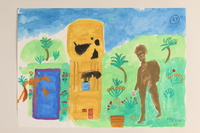
Painting
Object
Part of a collection of paintings: primarily gouache, created by Holocaust survivor Zenek Maor, documenting his experiences during the Holocaust and his life in Israel; Maor (born Moskowicz) was born in Wloclawek, Poland in 1923. His family fled to Warsaw, where they were forced into the ghetto. From there he was sent to a forced labor camp to build a railway line, before being transferred to Auschwitz with his brother Heniek. There they were assigned to a work detail in the Janinagrube coal mine. On January 17, 1945, Zenek and Heniek were forced on a death march towards Germany. After Zenek's liberation by the Red Army, he returned to Wloclawek to initially discover he was the only family member to return. Heniek and Zenek went to Bavaria, and Heniek eventually immigrated to the United States. Zenek immigrated to Israel in 1947, and married Hungarian survivor Lilli. They lived at Kibbutz Yad Mordecai and eventually moved to Haifa; created in 2005.
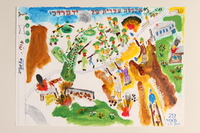
Painting
Object
Part of a collection of paintings: primarily gouache, created by Holocaust survivor Zenek Maor, documenting his experiences during the Holocaust and his life in Israel; Maor (born Moskowicz) was born in Wloclawek, Poland in 1923. His family fled to Warsaw, where they were forced into the ghetto. From there he was sent to a forced labor camp to build a railway line, before being transferred to Auschwitz with his brother Heniek. There they were assigned to a work detail in the Janinagrube coal mine. On January 17, 1945, Zenek and Heniek were forced on a death march towards Germany. After Zenek's liberation by the Red Army, he returned to Wloclawek to initially discover he was the only family member to return. Heniek and Zenek went to Bavaria, and Heniek eventually immigrated to the United States. Zenek immigrated to Israel in 1947, and married Hungarian survivor Lilli. They lived at Kibbutz Yad Mordecai and eventually moved to Haifa; created in 2005.

Painting
Object
Part of a collection of paintings: primarily gouache, created by Holocaust survivor Zenek Maor, documenting his experiences during the Holocaust and his life in Israel; Maor (born Moskowicz) was born in Wloclawek, Poland in 1923. His family fled to Warsaw, where they were forced into the ghetto. From there he was sent to a forced labor camp to build a railway line, before being transferred to Auschwitz with his brother Heniek. There they were assigned to a work detail in the Janinagrube coal mine. On January 17, 1945, Zenek and Heniek were forced on a death march towards Germany. After Zenek's liberation by the Red Army, he returned to Wloclawek to initially discover he was the only family member to return. Heniek and Zenek went to Bavaria, and Heniek eventually immigrated to the United States. Zenek immigrated to Israel in 1947, and married Hungarian survivor Lilli. They lived at Kibbutz Yad Mordecai and eventually moved to Haifa; created in 2005.
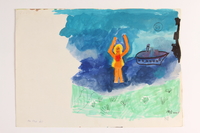
Painting
Object
Part of a collection of paintings: primarily gouache, created by Holocaust survivor Zenek Maor, documenting his experiences during the Holocaust and his life in Israel; Maor (born Moskowicz) was born in Wloclawek, Poland in 1923. His family fled to Warsaw, where they were forced into the ghetto. From there he was sent to a forced labor camp to build a railway line, before being transferred to Auschwitz with his brother Heniek. There they were assigned to a work detail in the Janinagrube coal mine. On January 17, 1945, Zenek and Heniek were forced on a death march towards Germany. After Zenek's liberation by the Red Army, he returned to Wloclawek to initially discover he was the only family member to return. Heniek and Zenek went to Bavaria, and Heniek eventually immigrated to the United States. Zenek immigrated to Israel in 1947, and married Hungarian survivor Lilli. They lived at Kibbutz Yad Mordecai and eventually moved to Haifa; created in 2005.

Painting
Object
Part of a collection of paintings: primarily gouache, created by Holocaust survivor Zenek Maor, documenting his experiences during the Holocaust and his life in Israel; Maor (born Moskowicz) was born in Wloclawek, Poland in 1923. His family fled to Warsaw, where they were forced into the ghetto. From there he was sent to a forced labor camp to build a railway line, before being transferred to Auschwitz with his brother Heniek. There they were assigned to a work detail in the Janinagrube coal mine. On January 17, 1945, Zenek and Heniek were forced on a death march towards Germany. After Zenek's liberation by the Red Army, he returned to Wloclawek to initially discover he was the only family member to return. Heniek and Zenek went to Bavaria, and Heniek eventually immigrated to the United States. Zenek immigrated to Israel in 1947, and married Hungarian survivor Lilli. They lived at Kibbutz Yad Mordecai and eventually moved to Haifa; created in 2005.

Painting
Object
Part of a collection of paintings: primarily gouache, created by Holocaust survivor Zenek Maor, documenting his experiences during the Holocaust and his life in Israel; Maor (born Moskowicz) was born in Wloclawek, Poland in 1923. His family fled to Warsaw, where they were forced into the ghetto. From there he was sent to a forced labor camp to build a railway line, before being transferred to Auschwitz with his brother Heniek. There they were assigned to a work detail in the Janinagrube coal mine. On January 17, 1945, Zenek and Heniek were forced on a death march towards Germany. After Zenek's liberation by the Red Army, he returned to Wloclawek to initially discover he was the only family member to return. Heniek and Zenek went to Bavaria, and Heniek eventually immigrated to the United States. Zenek immigrated to Israel in 1947, and married Hungarian survivor Lilli. They lived at Kibbutz Yad Mordecai and eventually moved to Haifa; created in 2005.

Painting
Object
Part of a collection of paintings: primarily gouache, created by Holocaust survivor Zenek Maor, documenting his experiences during the Holocaust and his life in Israel; Maor (born Moskowicz) was born in Wloclawek, Poland in 1923. His family fled to Warsaw, where they were forced into the ghetto. From there he was sent to a forced labor camp to build a railway line, before being transferred to Auschwitz with his brother Heniek. There they were assigned to a work detail in the Janinagrube coal mine. On January 17, 1945, Zenek and Heniek were forced on a death march towards Germany. After Zenek's liberation by the Red Army, he returned to Wloclawek to initially discover he was the only family member to return. Heniek and Zenek went to Bavaria, and Heniek eventually immigrated to the United States. Zenek immigrated to Israel in 1947, and married Hungarian survivor Lilli. They lived at Kibbutz Yad Mordecai and eventually moved to Haifa; created in 2005.

Painting
Object
Part of a collection of paintings: primarily gouache, created by Holocaust survivor Zenek Maor, documenting his experiences during the Holocaust and his life in Israel; Maor (born Moskowicz) was born in Wloclawek, Poland in 1923. His family fled to Warsaw, where they were forced into the ghetto. From there he was sent to a forced labor camp to build a railway line, before being transferred to Auschwitz with his brother Heniek. There they were assigned to a work detail in the Janinagrube coal mine. On January 17, 1945, Zenek and Heniek were forced on a death march towards Germany. After Zenek's liberation by the Red Army, he returned to Wloclawek to initially discover he was the only family member to return. Heniek and Zenek went to Bavaria, and Heniek eventually immigrated to the United States. Zenek immigrated to Israel in 1947, and married Hungarian survivor Lilli. They lived at Kibbutz Yad Mordecai and eventually moved to Haifa; created in 2005.
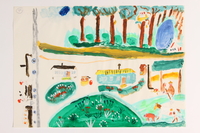
Painting
Object
Part of a collection of paintings: primarily gouache, created by Holocaust survivor Zenek Maor, documenting his experiences during the Holocaust and his life in Israel; Maor (born Moskowicz) was born in Wloclawek, Poland in 1923. His family fled to Warsaw, where they were forced into the ghetto. From there he was sent to a forced labor camp to build a railway line, before being transferred to Auschwitz with his brother Heniek. There they were assigned to a work detail in the Janinagrube coal mine. On January 17, 1945, Zenek and Heniek were forced on a death march towards Germany. After Zenek's liberation by the Red Army, he returned to Wloclawek to initially discover he was the only family member to return. Heniek and Zenek went to Bavaria, and Heniek eventually immigrated to the United States. Zenek immigrated to Israel in 1947, and married Hungarian survivor Lilli. They lived at Kibbutz Yad Mordecai and eventually moved to Haifa; created in 2005.

Painting
Object
Part of a collection of paintings: primarily gouache, created by Holocaust survivor Zenek Maor, documenting his experiences during the Holocaust and his life in Israel; Maor (born Moskowicz) was born in Wloclawek, Poland in 1923. His family fled to Warsaw, where they were forced into the ghetto. From there he was sent to a forced labor camp to build a railway line, before being transferred to Auschwitz with his brother Heniek. There they were assigned to a work detail in the Janinagrube coal mine. On January 17, 1945, Zenek and Heniek were forced on a death march towards Germany. After Zenek's liberation by the Red Army, he returned to Wloclawek to initially discover he was the only family member to return. Heniek and Zenek went to Bavaria, and Heniek eventually immigrated to the United States. Zenek immigrated to Israel in 1947, and married Hungarian survivor Lilli. They lived at Kibbutz Yad Mordecai and eventually moved to Haifa; created in 2005.
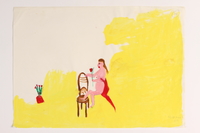
Painting
Object
Part of a collection of paintings: primarily gouache, created by Holocaust survivor Zenek Maor, documenting his experiences during the Holocaust and his life in Israel; Maor (born Moskowicz) was born in Wloclawek, Poland in 1923. His family fled to Warsaw, where they were forced into the ghetto. From there he was sent to a forced labor camp to build a railway line, before being transferred to Auschwitz with his brother Heniek. There they were assigned to a work detail in the Janinagrube coal mine. On January 17, 1945, Zenek and Heniek were forced on a death march towards Germany. After Zenek's liberation by the Red Army, he returned to Wloclawek to initially discover he was the only family member to return. Heniek and Zenek went to Bavaria, and Heniek eventually immigrated to the United States. Zenek immigrated to Israel in 1947, and married Hungarian survivor Lilli. They lived at Kibbutz Yad Mordecai and eventually moved to Haifa; created in 2005.

Painting
Object
Part of a collection of paintings: primarily gouache, created by Holocaust survivor Zenek Maor, documenting his experiences during the Holocaust and his life in Israel; Maor (born Moskowicz) was born in Wloclawek, Poland in 1923. His family fled to Warsaw, where they were forced into the ghetto. From there he was sent to a forced labor camp to build a railway line, before being transferred to Auschwitz with his brother Heniek. There they were assigned to a work detail in the Janinagrube coal mine. On January 17, 1945, Zenek and Heniek were forced on a death march towards Germany. After Zenek's liberation by the Red Army, he returned to Wloclawek to initially discover he was the only family member to return. Heniek and Zenek went to Bavaria, and Heniek eventually immigrated to the United States. Zenek immigrated to Israel in 1947, and married Hungarian survivor Lilli. They lived at Kibbutz Yad Mordecai and eventually moved to Haifa; created in 2005.

Painting
Object
Part of a collection of paintings: primarily gouache, created by Holocaust survivor Zenek Maor, documenting his experiences during the Holocaust and his life in Israel; Maor (born Moskowicz) was born in Wloclawek, Poland in 1923. His family fled to Warsaw, where they were forced into the ghetto. From there he was sent to a forced labor camp to build a railway line, before being transferred to Auschwitz with his brother Heniek. There they were assigned to a work detail in the Janinagrube coal mine. On January 17, 1945, Zenek and Heniek were forced on a death march towards Germany. After Zenek's liberation by the Red Army, he returned to Wloclawek to initially discover he was the only family member to return. Heniek and Zenek went to Bavaria, and Heniek eventually immigrated to the United States. Zenek immigrated to Israel in 1947, and married Hungarian survivor Lilli. They lived at Kibbutz Yad Mordecai and eventually moved to Haifa; created in 2005.

Painting
Object
Part of a collection of paintings: primarily gouache, created by Holocaust survivor Zenek Maor, documenting his experiences during the Holocaust and his life in Israel; Maor (born Moskowicz) was born in Wloclawek, Poland in 1923. His family fled to Warsaw, where they were forced into the ghetto. From there he was sent to a forced labor camp to build a railway line, before being transferred to Auschwitz with his brother Heniek. There they were assigned to a work detail in the Janinagrube coal mine. On January 17, 1945, Zenek and Heniek were forced on a death march towards Germany. After Zenek's liberation by the Red Army, he returned to Wloclawek to initially discover he was the only family member to return. Heniek and Zenek went to Bavaria, and Heniek eventually immigrated to the United States. Zenek immigrated to Israel in 1947, and married Hungarian survivor Lilli. They lived at Kibbutz Yad Mordecai and eventually moved to Haifa; created in 2005.

Painting
Object
Part of a collection of paintings: primarily gouache, created by Holocaust survivor Zenek Maor, documenting his experiences during the Holocaust and his life in Israel; Maor (born Moskowicz) was born in Wloclawek, Poland in 1923. His family fled to Warsaw, where they were forced into the ghetto. From there he was sent to a forced labor camp to build a railway line, before being transferred to Auschwitz with his brother Heniek. There they were assigned to a work detail in the Janinagrube coal mine. On January 17, 1945, Zenek and Heniek were forced on a death march towards Germany. After Zenek's liberation by the Red Army, he returned to Wloclawek to initially discover he was the only family member to return. Heniek and Zenek went to Bavaria, and Heniek eventually immigrated to the United States. Zenek immigrated to Israel in 1947, and married Hungarian survivor Lilli. They lived at Kibbutz Yad Mordecai and eventually moved to Haifa; created in 2005.

Painting
Object
Part of a collection of paintings: primarily gouache, created by Holocaust survivor Zenek Maor, documenting his experiences during the Holocaust and his life in Israel; Maor (born Moskowicz) was born in Wloclawek, Poland in 1923. His family fled to Warsaw, where they were forced into the ghetto. From there he was sent to a forced labor camp to build a railway line, before being transferred to Auschwitz with his brother Heniek. There they were assigned to a work detail in the Janinagrube coal mine. On January 17, 1945, Zenek and Heniek were forced on a death march towards Germany. After Zenek's liberation by the Red Army, he returned to Wloclawek to initially discover he was the only family member to return. Heniek and Zenek went to Bavaria, and Heniek eventually immigrated to the United States. Zenek immigrated to Israel in 1947, and married Hungarian survivor Lilli. They lived at Kibbutz Yad Mordecai and eventually moved to Haifa; created in 2005.

Painting
Object
Part of a collection of paintings: primarily gouache, created by Holocaust survivor Zenek Maor, documenting his experiences during the Holocaust and his life in Israel; Maor (born Moskowicz) was born in Wloclawek, Poland in 1923. His family fled to Warsaw, where they were forced into the ghetto. From there he was sent to a forced labor camp to build a railway line, before being transferred to Auschwitz with his brother Heniek. There they were assigned to a work detail in the Janinagrube coal mine. On January 17, 1945, Zenek and Heniek were forced on a death march towards Germany. After Zenek's liberation by the Red Army, he returned to Wloclawek to initially discover he was the only family member to return. Heniek and Zenek went to Bavaria, and Heniek eventually immigrated to the United States. Zenek immigrated to Israel in 1947, and married Hungarian survivor Lilli. They lived at Kibbutz Yad Mordecai and eventually moved to Haifa; created in 2005.

Painting
Object
Part of a collection of paintings: primarily gouache, created by Holocaust survivor Zenek Maor, documenting his experiences during the Holocaust and his life in Israel; Maor (born Moskowicz) was born in Wloclawek, Poland in 1923. His family fled to Warsaw, where they were forced into the ghetto. From there he was sent to a forced labor camp to build a railway line, before being transferred to Auschwitz with his brother Heniek. There they were assigned to a work detail in the Janinagrube coal mine. On January 17, 1945, Zenek and Heniek were forced on a death march towards Germany. After Zenek's liberation by the Red Army, he returned to Wloclawek to initially discover he was the only family member to return. Heniek and Zenek went to Bavaria, and Heniek eventually immigrated to the United States. Zenek immigrated to Israel in 1947, and married Hungarian survivor Lilli. They lived at Kibbutz Yad Mordecai and eventually moved to Haifa; created in 2005.
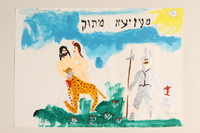
Painting
Object
Part of a collection of paintings: primarily gouache, created by Holocaust survivor Zenek Maor, documenting his experiences during the Holocaust and his life in Israel; Maor (born Moskowicz) was born in Wloclawek, Poland in 1923. His family fled to Warsaw, where they were forced into the ghetto. From there he was sent to a forced labor camp to build a railway line, before being transferred to Auschwitz with his brother Heniek. There they were assigned to a work detail in the Janinagrube coal mine. On January 17, 1945, Zenek and Heniek were forced on a death march towards Germany. After Zenek's liberation by the Red Army, he returned to Wloclawek to initially discover he was the only family member to return. Heniek and Zenek went to Bavaria, and Heniek eventually immigrated to the United States. Zenek immigrated to Israel in 1947, and married Hungarian survivor Lilli. They lived at Kibbutz Yad Mordecai and eventually moved to Haifa; created in 2005.

Painting
Object
Part of a collection of paintings: primarily gouache, created by Holocaust survivor Zenek Maor, documenting his experiences during the Holocaust and his life in Israel; Maor (born Moskowicz) was born in Wloclawek, Poland in 1923. His family fled to Warsaw, where they were forced into the ghetto. From there he was sent to a forced labor camp to build a railway line, before being transferred to Auschwitz with his brother Heniek. There they were assigned to a work detail in the Janinagrube coal mine. On January 17, 1945, Zenek and Heniek were forced on a death march towards Germany. After Zenek's liberation by the Red Army, he returned to Wloclawek to initially discover he was the only family member to return. Heniek and Zenek went to Bavaria, and Heniek eventually immigrated to the United States. Zenek immigrated to Israel in 1947, and married Hungarian survivor Lilli. They lived at Kibbutz Yad Mordecai and eventually moved to Haifa; created in 2005.

Painting
Object
Part of a collection of paintings: primarily gouache, created by Holocaust survivor Zenek Maor, documenting his experiences during the Holocaust and his life in Israel; Maor (born Moskowicz) was born in Wloclawek, Poland in 1923. His family fled to Warsaw, where they were forced into the ghetto. From there he was sent to a forced labor camp to build a railway line, before being transferred to Auschwitz with his brother Heniek. There they were assigned to a work detail in the Janinagrube coal mine. On January 17, 1945, Zenek and Heniek were forced on a death march towards Germany. After Zenek's liberation by the Red Army, he returned to Wloclawek to initially discover he was the only family member to return. Heniek and Zenek went to Bavaria, and Heniek eventually immigrated to the United States. Zenek immigrated to Israel in 1947, and married Hungarian survivor Lilli. They lived at Kibbutz Yad Mordecai and eventually moved to Haifa; created in 2005.

Painting
Object
Part of a collection of paintings: primarily gouache, created by Holocaust survivor Zenek Maor, documenting his experiences during the Holocaust and his life in Israel; Maor (born Moskowicz) was born in Wloclawek, Poland in 1923. His family fled to Warsaw, where they were forced into the ghetto. From there he was sent to a forced labor camp to build a railway line, before being transferred to Auschwitz with his brother Heniek. There they were assigned to a work detail in the Janinagrube coal mine. On January 17, 1945, Zenek and Heniek were forced on a death march towards Germany. After Zenek's liberation by the Red Army, he returned to Wloclawek to initially discover he was the only family member to return. Heniek and Zenek went to Bavaria, and Heniek eventually immigrated to the United States. Zenek immigrated to Israel in 1947, and married Hungarian survivor Lilli. They lived at Kibbutz Yad Mordecai and eventually moved to Haifa; created in 2005.

Painting
Object
Part of a collection of paintings: primarily gouache, created by Holocaust survivor Zenek Maor, documenting his experiences during the Holocaust and his life in Israel; Maor (born Moskowicz) was born in Wloclawek, Poland in 1923. His family fled to Warsaw, where they were forced into the ghetto. From there he was sent to a forced labor camp to build a railway line, before being transferred to Auschwitz with his brother Heniek. There they were assigned to a work detail in the Janinagrube coal mine. On January 17, 1945, Zenek and Heniek were forced on a death march towards Germany. After Zenek's liberation by the Red Army, he returned to Wloclawek to initially discover he was the only family member to return. Heniek and Zenek went to Bavaria, and Heniek eventually immigrated to the United States. Zenek immigrated to Israel in 1947, and married Hungarian survivor Lilli. They lived at Kibbutz Yad Mordecai and eventually moved to Haifa; created in 2005.
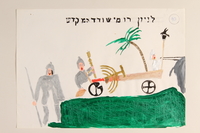
Painting
Object
Part of a collection of paintings: primarily gouache, created by Holocaust survivor Zenek Maor, documenting his experiences during the Holocaust and his life in Israel; Maor (born Moskowicz) was born in Wloclawek, Poland in 1923. His family fled to Warsaw, where they were forced into the ghetto. From there he was sent to a forced labor camp to build a railway line, before being transferred to Auschwitz with his brother Heniek. There they were assigned to a work detail in the Janinagrube coal mine. On January 17, 1945, Zenek and Heniek were forced on a death march towards Germany. After Zenek's liberation by the Red Army, he returned to Wloclawek to initially discover he was the only family member to return. Heniek and Zenek went to Bavaria, and Heniek eventually immigrated to the United States. Zenek immigrated to Israel in 1947, and married Hungarian survivor Lilli. They lived at Kibbutz Yad Mordecai and eventually moved to Haifa; created in 2005.

Painting
Object
Part of a collection of paintings: primarily gouache, created by Holocaust survivor Zenek Maor, documenting his experiences during the Holocaust and his life in Israel; Maor (born Moskowicz) was born in Wloclawek, Poland in 1923. His family fled to Warsaw, where they were forced into the ghetto. From there he was sent to a forced labor camp to build a railway line, before being transferred to Auschwitz with his brother Heniek. There they were assigned to a work detail in the Janinagrube coal mine. On January 17, 1945, Zenek and Heniek were forced on a death march towards Germany. After Zenek's liberation by the Red Army, he returned to Wloclawek to initially discover he was the only family member to return. Heniek and Zenek went to Bavaria, and Heniek eventually immigrated to the United States. Zenek immigrated to Israel in 1947, and married Hungarian survivor Lilli. They lived at Kibbutz Yad Mordecai and eventually moved to Haifa; created in 2005.

Painting
Object
Part of a collection of paintings: primarily gouache, created by Holocaust survivor Zenek Maor, documenting his experiences during the Holocaust and his life in Israel; Maor (born Moskowicz) was born in Wloclawek, Poland in 1923. His family fled to Warsaw, where they were forced into the ghetto. From there he was sent to a forced labor camp to build a railway line, before being transferred to Auschwitz with his brother Heniek. There they were assigned to a work detail in the Janinagrube coal mine. On January 17, 1945, Zenek and Heniek were forced on a death march towards Germany. After Zenek's liberation by the Red Army, he returned to Wloclawek to initially discover he was the only family member to return. Heniek and Zenek went to Bavaria, and Heniek eventually immigrated to the United States. Zenek immigrated to Israel in 1947, and married Hungarian survivor Lilli. They lived at Kibbutz Yad Mordecai and eventually moved to Haifa; created in 2005.

Painting
Object
Part of a collection of paintings: primarily gouache, created by Holocaust survivor Zenek Maor, documenting his experiences during the Holocaust and his life in Israel; Maor (born Moskowicz) was born in Wloclawek, Poland in 1923. His family fled to Warsaw, where they were forced into the ghetto. From there he was sent to a forced labor camp to build a railway line, before being transferred to Auschwitz with his brother Heniek. There they were assigned to a work detail in the Janinagrube coal mine. On January 17, 1945, Zenek and Heniek were forced on a death march towards Germany. After Zenek's liberation by the Red Army, he returned to Wloclawek to initially discover he was the only family member to return. Heniek and Zenek went to Bavaria, and Heniek eventually immigrated to the United States. Zenek immigrated to Israel in 1947, and married Hungarian survivor Lilli. They lived at Kibbutz Yad Mordecai and eventually moved to Haifa; created in 2005.

Painting
Object
Part of a collection of paintings: primarily gouache, created by Holocaust survivor Zenek Maor, documenting his experiences during the Holocaust and his life in Israel; Maor (born Moskowicz) was born in Wloclawek, Poland in 1923. His family fled to Warsaw, where they were forced into the ghetto. From there he was sent to a forced labor camp to build a railway line, before being transferred to Auschwitz with his brother Heniek. There they were assigned to a work detail in the Janinagrube coal mine. On January 17, 1945, Zenek and Heniek were forced on a death march towards Germany. After Zenek's liberation by the Red Army, he returned to Wloclawek to initially discover he was the only family member to return. Heniek and Zenek went to Bavaria, and Heniek eventually immigrated to the United States. Zenek immigrated to Israel in 1947, and married Hungarian survivor Lilli. They lived at Kibbutz Yad Mordecai and eventually moved to Haifa; created in 2005.
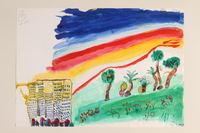
Painting
Object
Part of a collection of paintings: primarily gouache, created by Holocaust survivor Zenek Maor, documenting his experiences during the Holocaust and his life in Israel; Maor (born Moskowicz) was born in Wloclawek, Poland in 1923. His family fled to Warsaw, where they were forced into the ghetto. From there he was sent to a forced labor camp to build a railway line, before being transferred to Auschwitz with his brother Heniek. There they were assigned to a work detail in the Janinagrube coal mine. On January 17, 1945, Zenek and Heniek were forced on a death march towards Germany. After Zenek's liberation by the Red Army, he returned to Wloclawek to initially discover he was the only family member to return. Heniek and Zenek went to Bavaria, and Heniek eventually immigrated to the United States. Zenek immigrated to Israel in 1947, and married Hungarian survivor Lilli. They lived at Kibbutz Yad Mordecai and eventually moved to Haifa; created in 2005.
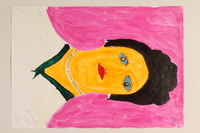
Painting
Object
Part of a collection of paintings: primarily gouache, created by Holocaust survivor Zenek Maor, documenting his experiences during the Holocaust and his life in Israel; Maor (born Moskowicz) was born in Wloclawek, Poland in 1923. His family fled to Warsaw, where they were forced into the ghetto. From there he was sent to a forced labor camp to build a railway line, before being transferred to Auschwitz with his brother Heniek. There they were assigned to a work detail in the Janinagrube coal mine. On January 17, 1945, Zenek and Heniek were forced on a death march towards Germany. After Zenek's liberation by the Red Army, he returned to Wloclawek to initially discover he was the only family member to return. Heniek and Zenek went to Bavaria, and Heniek eventually immigrated to the United States. Zenek immigrated to Israel in 1947, and married Hungarian survivor Lilli. They lived at Kibbutz Yad Mordecai and eventually moved to Haifa; created in 2005.
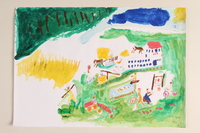
Painting
Object
Part of a collection of paintings: primarily gouache, created by Holocaust survivor Zenek Maor, documenting his experiences during the Holocaust and his life in Israel; Maor (born Moskowicz) was born in Wloclawek, Poland in 1923. His family fled to Warsaw, where they were forced into the ghetto. From there he was sent to a forced labor camp to build a railway line, before being transferred to Auschwitz with his brother Heniek. There they were assigned to a work detail in the Janinagrube coal mine. On January 17, 1945, Zenek and Heniek were forced on a death march towards Germany. After Zenek's liberation by the Red Army, he returned to Wloclawek to initially discover he was the only family member to return. Heniek and Zenek went to Bavaria, and Heniek eventually immigrated to the United States. Zenek immigrated to Israel in 1947, and married Hungarian survivor Lilli. They lived at Kibbutz Yad Mordecai and eventually moved to Haifa; created in 2005.

Painting
Object
Part of a collection of paintings: primarily gouache, created by Holocaust survivor Zenek Maor, documenting his experiences during the Holocaust and his life in Israel; Maor (born Moskowicz) was born in Wloclawek, Poland in 1923. His family fled to Warsaw, where they were forced into the ghetto. From there he was sent to a forced labor camp to build a railway line, before being transferred to Auschwitz with his brother Heniek. There they were assigned to a work detail in the Janinagrube coal mine. On January 17, 1945, Zenek and Heniek were forced on a death march towards Germany. After Zenek's liberation by the Red Army, he returned to Wloclawek to initially discover he was the only family member to return. Heniek and Zenek went to Bavaria, and Heniek eventually immigrated to the United States. Zenek immigrated to Israel in 1947, and married Hungarian survivor Lilli. They lived at Kibbutz Yad Mordecai and eventually moved to Haifa; created in 2005.

Painting
Object
Part of a collection of paintings: primarily gouache, created by Holocaust survivor Zenek Maor, documenting his experiences during the Holocaust and his life in Israel; Maor (born Moskowicz) was born in Wloclawek, Poland in 1923. His family fled to Warsaw, where they were forced into the ghetto. From there he was sent to a forced labor camp to build a railway line, before being transferred to Auschwitz with his brother Heniek. There they were assigned to a work detail in the Janinagrube coal mine. On January 17, 1945, Zenek and Heniek were forced on a death march towards Germany. After Zenek's liberation by the Red Army, he returned to Wloclawek to initially discover he was the only family member to return. Heniek and Zenek went to Bavaria, and Heniek eventually immigrated to the United States. Zenek immigrated to Israel in 1947, and married Hungarian survivor Lilli. They lived at Kibbutz Yad Mordecai and eventually moved to Haifa; created in 2005.
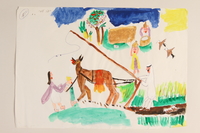
Painting
Object
Part of a collection of paintings: primarily gouache, created by Holocaust survivor Zenek Maor, documenting his experiences during the Holocaust and his life in Israel; Maor (born Moskowicz) was born in Wloclawek, Poland in 1923. His family fled to Warsaw, where they were forced into the ghetto. From there he was sent to a forced labor camp to build a railway line, before being transferred to Auschwitz with his brother Heniek. There they were assigned to a work detail in the Janinagrube coal mine. On January 17, 1945, Zenek and Heniek were forced on a death march towards Germany. After Zenek's liberation by the Red Army, he returned to Wloclawek to initially discover he was the only family member to return. Heniek and Zenek went to Bavaria, and Heniek eventually immigrated to the United States. Zenek immigrated to Israel in 1947, and married Hungarian survivor Lilli. They lived at Kibbutz Yad Mordecai and eventually moved to Haifa; created in 2005.

Painting
Object
Part of a collection of paintings: primarily gouache, created by Holocaust survivor Zenek Maor, documenting his experiences during the Holocaust and his life in Israel; Maor (born Moskowicz) was born in Wloclawek, Poland in 1923. His family fled to Warsaw, where they were forced into the ghetto. From there he was sent to a forced labor camp to build a railway line, before being transferred to Auschwitz with his brother Heniek. There they were assigned to a work detail in the Janinagrube coal mine. On January 17, 1945, Zenek and Heniek were forced on a death march towards Germany. After Zenek's liberation by the Red Army, he returned to Wloclawek to initially discover he was the only family member to return. Heniek and Zenek went to Bavaria, and Heniek eventually immigrated to the United States. Zenek immigrated to Israel in 1947, and married Hungarian survivor Lilli. They lived at Kibbutz Yad Mordecai and eventually moved to Haifa; created in 2005.

Painting
Object
Part of a collection of paintings: primarily gouache, created by Holocaust survivor Zenek Maor, documenting his experiences during the Holocaust and his life in Israel; Maor (born Moskowicz) was born in Wloclawek, Poland in 1923. His family fled to Warsaw, where they were forced into the ghetto. From there he was sent to a forced labor camp to build a railway line, before being transferred to Auschwitz with his brother Heniek. There they were assigned to a work detail in the Janinagrube coal mine. On January 17, 1945, Zenek and Heniek were forced on a death march towards Germany. After Zenek's liberation by the Red Army, he returned to Wloclawek to initially discover he was the only family member to return. Heniek and Zenek went to Bavaria, and Heniek eventually immigrated to the United States. Zenek immigrated to Israel in 1947, and married Hungarian survivor Lilli. They lived at Kibbutz Yad Mordecai and eventually moved to Haifa; created in 2005.

Painting
Object
Part of a collection of paintings: primarily gouache, created by Holocaust survivor Zenek Maor, documenting his experiences during the Holocaust and his life in Israel; Maor (born Moskowicz) was born in Wloclawek, Poland in 1923. His family fled to Warsaw, where they were forced into the ghetto. From there he was sent to a forced labor camp to build a railway line, before being transferred to Auschwitz with his brother Heniek. There they were assigned to a work detail in the Janinagrube coal mine. On January 17, 1945, Zenek and Heniek were forced on a death march towards Germany. After Zenek's liberation by the Red Army, he returned to Wloclawek to initially discover he was the only family member to return. Heniek and Zenek went to Bavaria, and Heniek eventually immigrated to the United States. Zenek immigrated to Israel in 1947, and married Hungarian survivor Lilli. They lived at Kibbutz Yad Mordecai and eventually moved to Haifa; created in 2005.

Painting
Object
Part of a collection of paintings: primarily gouache, created by Holocaust survivor Zenek Maor, documenting his experiences during the Holocaust and his life in Israel; Maor (born Moskowicz) was born in Wloclawek, Poland in 1923. His family fled to Warsaw, where they were forced into the ghetto. From there he was sent to a forced labor camp to build a railway line, before being transferred to Auschwitz with his brother Heniek. There they were assigned to a work detail in the Janinagrube coal mine. On January 17, 1945, Zenek and Heniek were forced on a death march towards Germany. After Zenek's liberation by the Red Army, he returned to Wloclawek to initially discover he was the only family member to return. Heniek and Zenek went to Bavaria, and Heniek eventually immigrated to the United States. Zenek immigrated to Israel in 1947, and married Hungarian survivor Lilli. They lived at Kibbutz Yad Mordecai and eventually moved to Haifa; created in 2005.

Painting
Object
Part of a collection of paintings: primarily gouache, created by Holocaust survivor Zenek Maor, documenting his experiences during the Holocaust and his life in Israel; Maor (born Moskowicz) was born in Wloclawek, Poland in 1923. His family fled to Warsaw, where they were forced into the ghetto. From there he was sent to a forced labor camp to build a railway line, before being transferred to Auschwitz with his brother Heniek. There they were assigned to a work detail in the Janinagrube coal mine. On January 17, 1945, Zenek and Heniek were forced on a death march towards Germany. After Zenek's liberation by the Red Army, he returned to Wloclawek to initially discover he was the only family member to return. Heniek and Zenek went to Bavaria, and Heniek eventually immigrated to the United States. Zenek immigrated to Israel in 1947, and married Hungarian survivor Lilli. They lived at Kibbutz Yad Mordecai and eventually moved to Haifa; created in 2005.

Painting
Object
Part of a collection of paintings: primarily gouache, created by Holocaust survivor Zenek Maor, documenting his experiences during the Holocaust and his life in Israel; Maor (born Moskowicz) was born in Wloclawek, Poland in 1923. His family fled to Warsaw, where they were forced into the ghetto. From there he was sent to a forced labor camp to build a railway line, before being transferred to Auschwitz with his brother Heniek. There they were assigned to a work detail in the Janinagrube coal mine. On January 17, 1945, Zenek and Heniek were forced on a death march towards Germany. After Zenek's liberation by the Red Army, he returned to Wloclawek to initially discover he was the only family member to return. Heniek and Zenek went to Bavaria, and Heniek eventually immigrated to the United States. Zenek immigrated to Israel in 1947, and married Hungarian survivor Lilli. They lived at Kibbutz Yad Mordecai and eventually moved to Haifa; created in 2005.

Painting
Object
Part of a collection of paintings: primarily gouache, created by Holocaust survivor Zenek Maor, documenting his experiences during the Holocaust and his life in Israel; Maor (born Moskowicz) was born in Wloclawek, Poland in 1923. His family fled to Warsaw, where they were forced into the ghetto. From there he was sent to a forced labor camp to build a railway line, before being transferred to Auschwitz with his brother Heniek. There they were assigned to a work detail in the Janinagrube coal mine. On January 17, 1945, Zenek and Heniek were forced on a death march towards Germany. After Zenek's liberation by the Red Army, he returned to Wloclawek to initially discover he was the only family member to return. Heniek and Zenek went to Bavaria, and Heniek eventually immigrated to the United States. Zenek immigrated to Israel in 1947, and married Hungarian survivor Lilli. They lived at Kibbutz Yad Mordecai and eventually moved to Haifa; created in 2005.

Painting
Object
Part of a collection of paintings: primarily gouache, created by Holocaust survivor Zenek Maor, documenting his experiences during the Holocaust and his life in Israel; Maor (born Moskowicz) was born in Wloclawek, Poland in 1923. His family fled to Warsaw, where they were forced into the ghetto. From there he was sent to a forced labor camp to build a railway line, before being transferred to Auschwitz with his brother Heniek. There they were assigned to a work detail in the Janinagrube coal mine. On January 17, 1945, Zenek and Heniek were forced on a death march towards Germany. After Zenek's liberation by the Red Army, he returned to Wloclawek to initially discover he was the only family member to return. Heniek and Zenek went to Bavaria, and Heniek eventually immigrated to the United States. Zenek immigrated to Israel in 1947, and married Hungarian survivor Lilli. They lived at Kibbutz Yad Mordecai and eventually moved to Haifa; created in 2005.

Painting
Object
Part of a collection of paintings: primarily gouache, created by Holocaust survivor Zenek Maor, documenting his experiences during the Holocaust and his life in Israel; Maor (born Moskowicz) was born in Wloclawek, Poland in 1923. His family fled to Warsaw, where they were forced into the ghetto. From there he was sent to a forced labor camp to build a railway line, before being transferred to Auschwitz with his brother Heniek. There they were assigned to a work detail in the Janinagrube coal mine. On January 17, 1945, Zenek and Heniek were forced on a death march towards Germany. After Zenek's liberation by the Red Army, he returned to Wloclawek to initially discover he was the only family member to return. Heniek and Zenek went to Bavaria, and Heniek eventually immigrated to the United States. Zenek immigrated to Israel in 1947, and married Hungarian survivor Lilli. They lived at Kibbutz Yad Mordecai and eventually moved to Haifa; created in 2005.

Painting
Object
Part of a collection of paintings: primarily gouache, created by Holocaust survivor Zenek Maor, documenting his experiences during the Holocaust and his life in Israel; Maor (born Moskowicz) was born in Wloclawek, Poland in 1923. His family fled to Warsaw, where they were forced into the ghetto. From there he was sent to a forced labor camp to build a railway line, before being transferred to Auschwitz with his brother Heniek. There they were assigned to a work detail in the Janinagrube coal mine. On January 17, 1945, Zenek and Heniek were forced on a death march towards Germany. After Zenek's liberation by the Red Army, he returned to Wloclawek to initially discover he was the only family member to return. Heniek and Zenek went to Bavaria, and Heniek eventually immigrated to the United States. Zenek immigrated to Israel in 1947, and married Hungarian survivor Lilli. They lived at Kibbutz Yad Mordecai and eventually moved to Haifa; created in 2005.

Painting
Object
Part of a collection of paintings: primarily gouache, created by Holocaust survivor Zenek Maor, documenting his experiences during the Holocaust and his life in Israel; Maor (born Moskowicz) was born in Wloclawek, Poland in 1923. His family fled to Warsaw, where they were forced into the ghetto. From there he was sent to a forced labor camp to build a railway line, before being transferred to Auschwitz with his brother Heniek. There they were assigned to a work detail in the Janinagrube coal mine. On January 17, 1945, Zenek and Heniek were forced on a death march towards Germany. After Zenek's liberation by the Red Army, he returned to Wloclawek to initially discover he was the only family member to return. Heniek and Zenek went to Bavaria, and Heniek eventually immigrated to the United States. Zenek immigrated to Israel in 1947, and married Hungarian survivor Lilli. They lived at Kibbutz Yad Mordecai and eventually moved to Haifa; created in 2005.

Painting
Object
Part of a collection of paintings: primarily gouache, created by Holocaust survivor Zenek Maor, documenting his experiences during the Holocaust and his life in Israel; Maor (born Moskowicz) was born in Wloclawek, Poland in 1923. His family fled to Warsaw, where they were forced into the ghetto. From there he was sent to a forced labor camp to build a railway line, before being transferred to Auschwitz with his brother Heniek. There they were assigned to a work detail in the Janinagrube coal mine. On January 17, 1945, Zenek and Heniek were forced on a death march towards Germany. After Zenek's liberation by the Red Army, he returned to Wloclawek to initially discover he was the only family member to return. Heniek and Zenek went to Bavaria, and Heniek eventually immigrated to the United States. Zenek immigrated to Israel in 1947, and married Hungarian survivor Lilli. They lived at Kibbutz Yad Mordecai and eventually moved to Haifa; created in 2005.

Painting
Object
Part of a collection of paintings: primarily gouache, created by Holocaust survivor Zenek Maor, documenting his experiences during the Holocaust and his life in Israel; Maor (born Moskowicz) was born in Wloclawek, Poland in 1923. His family fled to Warsaw, where they were forced into the ghetto. From there he was sent to a forced labor camp to build a railway line, before being transferred to Auschwitz with his brother Heniek. There they were assigned to a work detail in the Janinagrube coal mine. On January 17, 1945, Zenek and Heniek were forced on a death march towards Germany. After Zenek's liberation by the Red Army, he returned to Wloclawek to initially discover he was the only family member to return. Heniek and Zenek went to Bavaria, and Heniek eventually immigrated to the United States. Zenek immigrated to Israel in 1947, and married Hungarian survivor Lilli. They lived at Kibbutz Yad Mordecai and eventually moved to Haifa; created in 2005.

Painting
Object
Part of a collection of paintings: primarily gouache, created by Holocaust survivor Zenek Maor, documenting his experiences during the Holocaust and his life in Israel; Maor (born Moskowicz) was born in Wloclawek, Poland in 1923. His family fled to Warsaw, where they were forced into the ghetto. From there he was sent to a forced labor camp to build a railway line, before being transferred to Auschwitz with his brother Heniek. There they were assigned to a work detail in the Janinagrube coal mine. On January 17, 1945, Zenek and Heniek were forced on a death march towards Germany. After Zenek's liberation by the Red Army, he returned to Wloclawek to initially discover he was the only family member to return. Heniek and Zenek went to Bavaria, and Heniek eventually immigrated to the United States. Zenek immigrated to Israel in 1947, and married Hungarian survivor Lilli. They lived at Kibbutz Yad Mordecai and eventually moved to Haifa; created in 2005.

Painting
Object
Part of a collection of paintings: primarily gouache, created by Holocaust survivor Zenek Maor, documenting his experiences during the Holocaust and his life in Israel; Maor (born Moskowicz) was born in Wloclawek, Poland in 1923. His family fled to Warsaw, where they were forced into the ghetto. From there he was sent to a forced labor camp to build a railway line, before being transferred to Auschwitz with his brother Heniek. There they were assigned to a work detail in the Janinagrube coal mine. On January 17, 1945, Zenek and Heniek were forced on a death march towards Germany. After Zenek's liberation by the Red Army, he returned to Wloclawek to initially discover he was the only family member to return. Heniek and Zenek went to Bavaria, and Heniek eventually immigrated to the United States. Zenek immigrated to Israel in 1947, and married Hungarian survivor Lilli. They lived at Kibbutz Yad Mordecai and eventually moved to Haifa; created in 2005.
Spis zarejestrowanych w Komitecie Pomocy Deportowanym Żydem,- Obywatelem Polskim na Węgrzech w czasie od 15. kwietnia do 15. listopada 1945.
Document
Typescript, bound, 151 pages, containing the names of Polish Jews who arrived in Hungary at the conclusion of World War II, and who were registered by the Committee to Aid Deported Jews (of Polish citizenry) in Hungary, between April and November 1945. The list contains the names, in alphabetic order by last name, and for each individual, the date and place of birth, place of residence (prior to deportation), and other characteristics, such as occupation or name of spouse or parents. Created by the committee in Budapest, November 1945.



